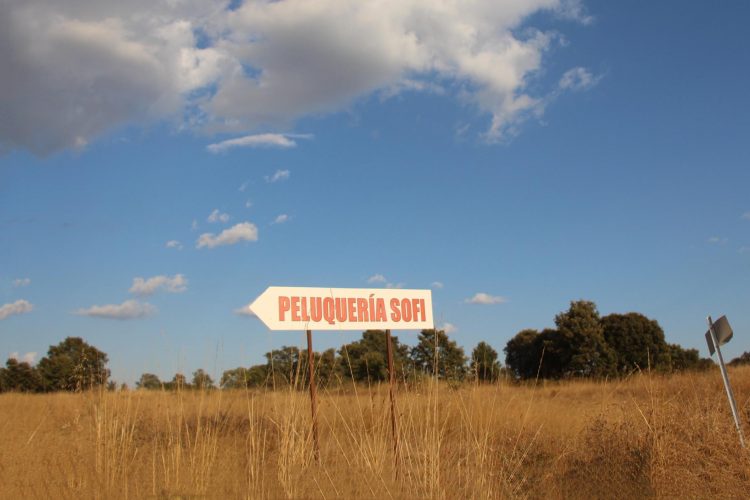Basilicata: the Italian villages resisting depopulation
According to Istat, Basilicata is the region in Italy that has been hardest hit by rural depopulation. It’s an area in which 56% of the population is concentrated in the two biggest cities and agriculture provides livelihoods for the majority of rural inhabitants. Villages and towns have witnessed their population reduced by more than half when, just 30 years ago, they were thriving areas with tens of thousands of residents. The city of Matera is European Capital of Culture for 2019, yet it is surrounded by a rural desert. Despite these trends, there are still young people who resist, trying to repopulate their hometowns and bring life back to the land – each in their own original way.
“You feel the desire to return to fresh air. To the countryside that’s waiting for me to relive the glory days. This magical feeling repeats itself, year after year when I see you, my bittersweet town. I can’t leave you anymore.” Milena and Maria Luigia grew up in a ghost town where everything pretty much stopped in the 50s. It’s less than an hour from Matera, the capital of Basilicata – a region in the center of Southern Italy. In 70 years the city has gone from being “a national disgrace” – at least according to Palmiro Togliatti, former secretary of the Italian Communist Party (PCI) – to being European Capital for Culture for 2019. The two sisters showed us a land that’s lost its soul, where it’s difficult to distinguish between an inhabited house and an abandoned one.
To help us see the region from another perspective, they gave us a CD by singer-songwriter Pietro Cirillo. His view of Basilicata is one of resistance. His sound is both magical and hypnotic, describing a continuous search for the self beginning in the same nostalgic, rural world in which Maria Luigia and Milena were raised. Thus begins our journey in search of people who made the decision to stay in the most depopulated regions of the Bel Paese. Of people who left only to return because, as the Luigia sisters explained to us, “Your roots will always call you back.” Of people who came to these regions for the first time, after a life spent feeling other winds on their faces, climbing other mountains and swimming in other seas.
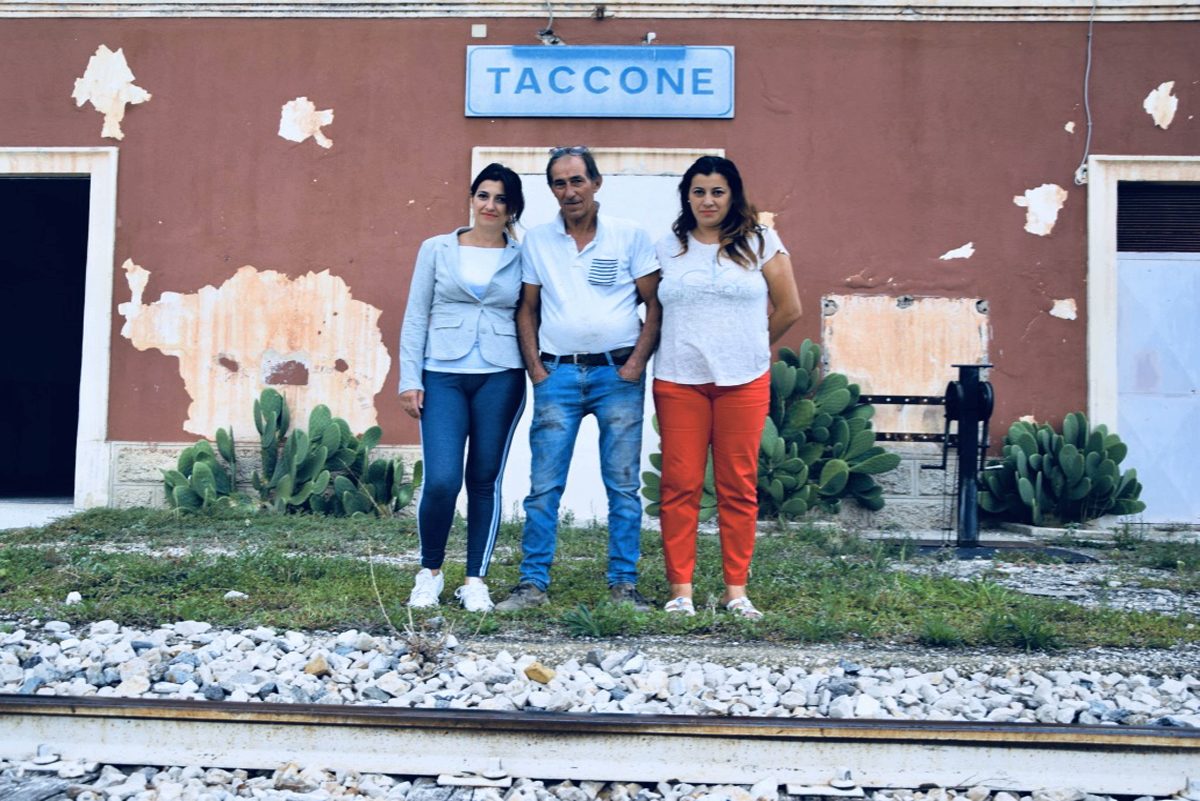
The only family in Borgo Taccone
©Veronica Di Benedetto Montaccini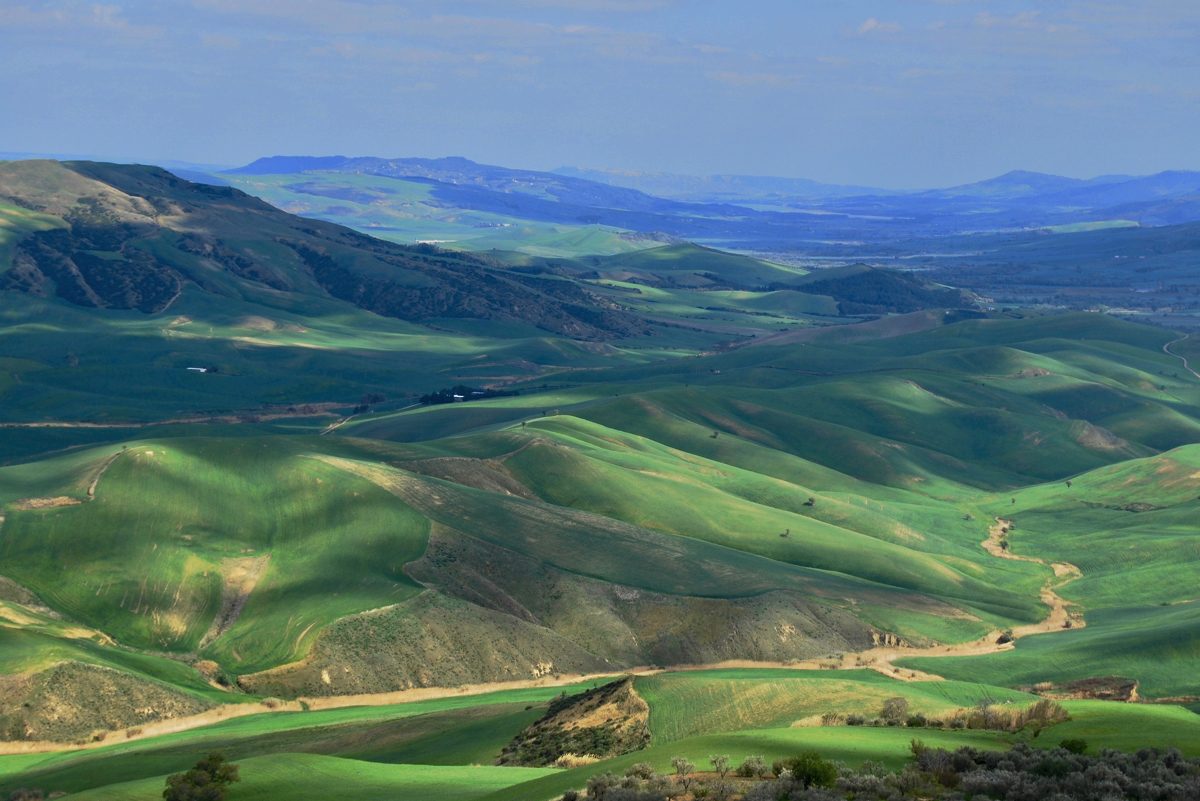
Basilicata’s landscape
©Veronica Di Benedetto Montaccini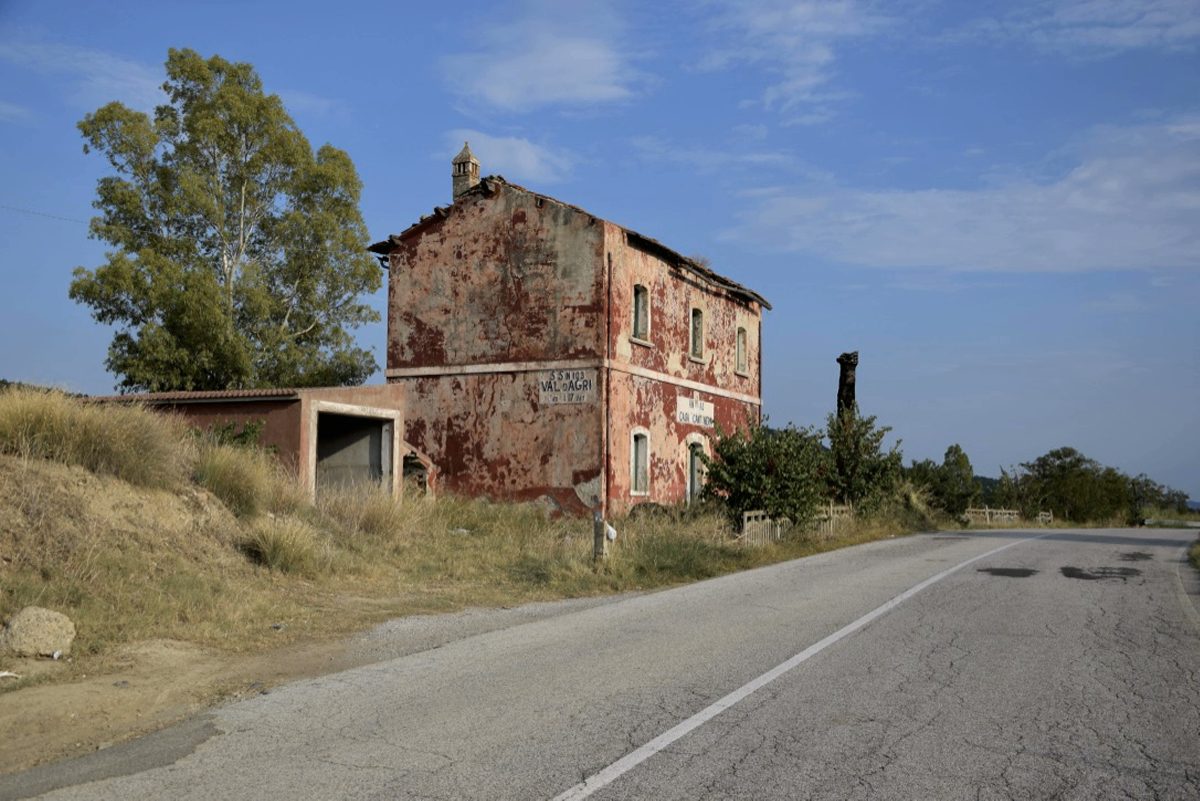
Empty road
©Veronica Di Benedetto Montaccini
The Data
Basilicata is struggling against a constant rate of population decline – there are roughly 3,000 less people in the region each year. The area is characterised by low birth rates and a high level of emigration. According to the last Svimez report, population – currently at 570,365 – is set to fall as low as 400,000. There are no big cities in the former Roman province of Lucania. If we were to exclude the two provincial capitals – Potenza (population 67,168) and Matera (population 60,351) – all the other city centres have fewer than 20 000 residents (data from Istat).
Ettore Bove, Professor of Agricultural Economics and Politics at the University of Basilicata, does not deny that demographic change in the region constitutes a real emergency. He is convinced that creating an adequate tourist network could solve the problem. “Basilicata is divided into two parts: on the one hand, we have the ‘meat’ which corresponds to the more developed areas such as Matera and the coast. On the other, there is the ‘bone’, or more disadvantaged areas. This contrast will only increase unless action is taken.” He singles out tourism as a means of reversing this territorial abandonment. “We need to identify and promote local resources in order to create tourist networks based on culture, ecology and science. The real challenge is to stop tourist presence from being a seasonal thing.”
Out of 131 municipalities in the region, 27 have less than 1,000 residents. Some of them run the risk of being completely uninhabited in as little as 10 years. In some, however, citizens and institutions have reacted to this demographic haemorrhage by proposing tourism and culture plans which have guaranteed their villages’ survival. In some cases, such development seemed almost unfathomable a few years ago.
There’s Irsina, a village in the hills that owes its rebirth to its foreign residents. In Borgo Taccone, one last family lives there year-round, dreaming of reviving the village cinema. There’s Guardia Perticara, a village who struck oil and saved itself from vanishing. In certain inland areas, life is especially complicated. Yet, even here, young people are not giving up. Craco’s medieval atmosphere has led to this otherwise abandoned village becoming the backdrop for many a film, while the language and colourful traditional dress of Albania have attracted curious tourists as well as historians to the tiny town of San Paolo Albanese.
Irsina, a home for citizens of the world
We get to Irsina on the last day of a festival dedicated to Saint Eufemia. A recurring celebration that is a tribute to the city’s patron saint and an important date in the calendar for the whole community. Four days are dedicated to Saint Eufemia, whom, legend has it, lions refused to eat. During the festival, Irsina’s population triples in size. But after the party, everything goes back to normal.
Today, the number of residents is less than 5,000 and decreasing year on year. “The first wave of emigration was in the 60s,” says Nicola Morea. Born in 1978, and mayor of Irsina since 2015, he returned to his hometown after 10 years as a lawyer in Milan. “Agrarian reforms were not providing the expected results. Seven hectares of land had been given to each resident, but it was not enough to cultivate wheat so families began to head north – in particular to Sassuolo, where the ceramic industry was growing.”

Irsina ©Veronica Di Benedetto Montaccini 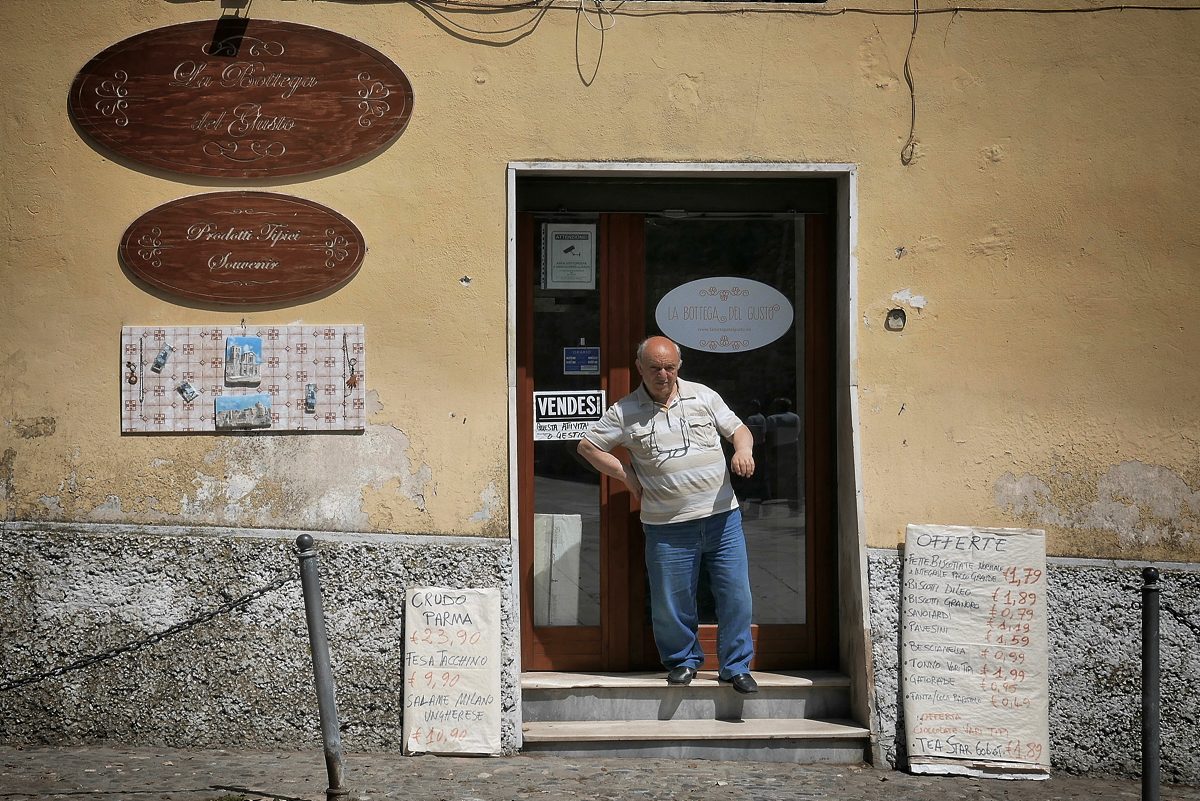
Waiting for… ©Veronica Di Benedetto Montaccini 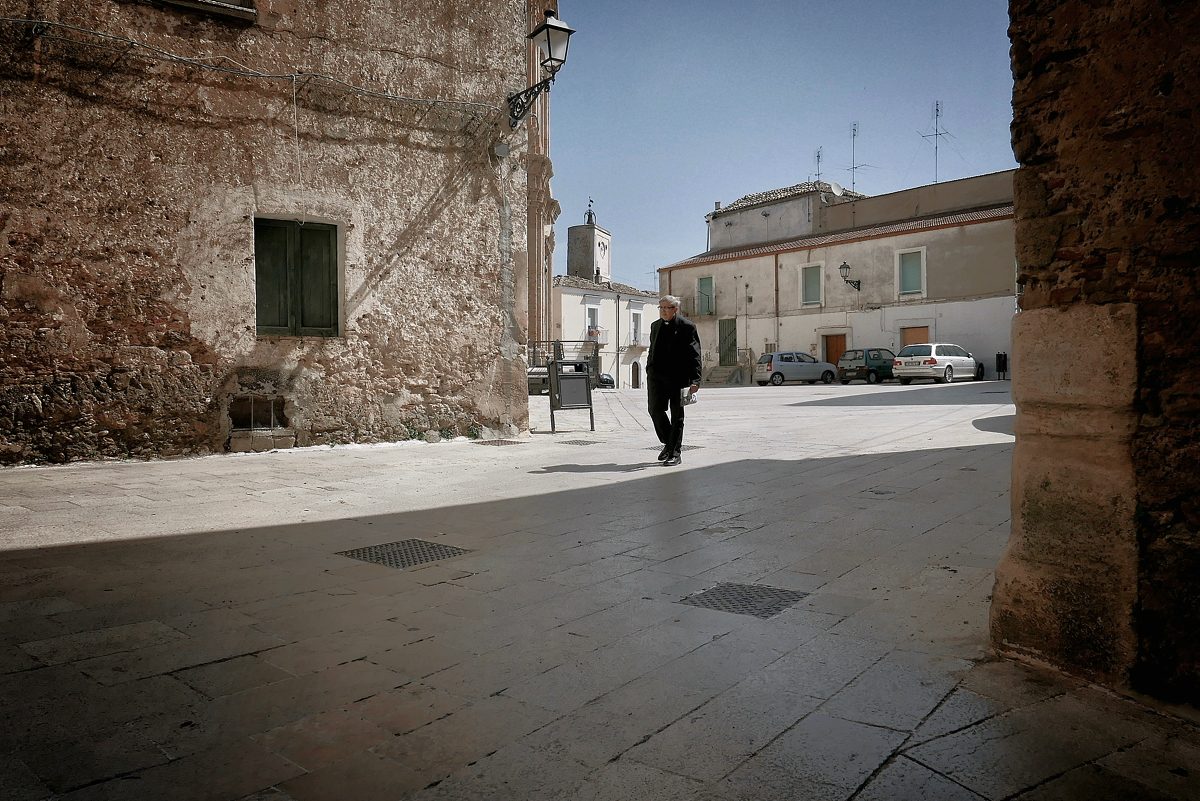
Holy land ©Veronica Di Benedetto Montaccini 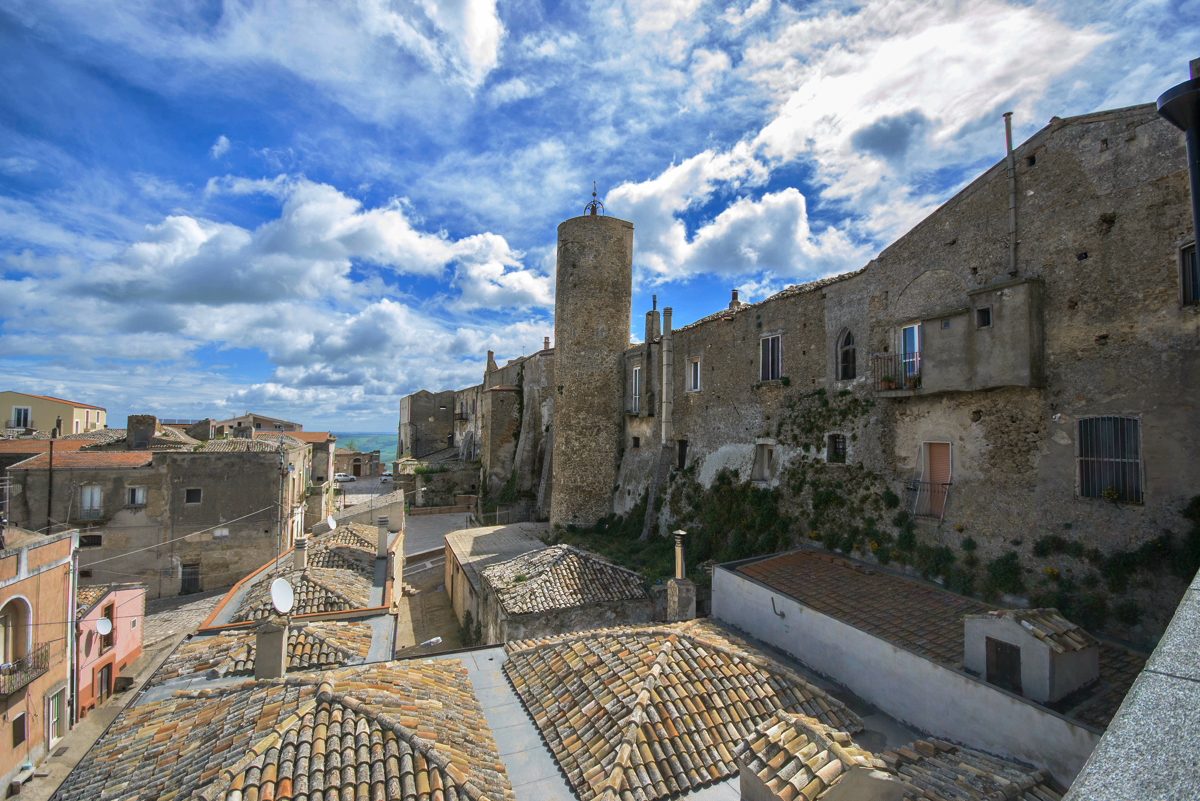
Irsina’s landscape ©Veronica Di Benedetto Montaccini
As a consequence, there exists a sort of “Irsina subsidiary” in the Modena countryside, at Emilia Romagna. Though if you look at the numbers, this would actually be considered head office: around 8,000 people who can trace their roots to Irsina currently live in Sassuolo, a town of 40,000 people. At a fifth of the population of the town, this constitutes one of the largest communities in an Italian city to have emigrated away from their hometown. In Sassuolo, Saint Eufemia is also celebrated, hardly a surprise given that there are more residents in the town from Irsina than there are in Irsina itself.
The two municipalities have been twinned since the 80s and the mayors are friends, working with one another on a project to highlight the impact of Basilicata emigration on the Emilia Romagna region. Nicola, like others, heard an inner call to return to Irsina. “Sooner or later your origins call you back. You feel it,” he explains, offering us yet another coffee. We take a walk through the village, one of the oldest in Basilicata.
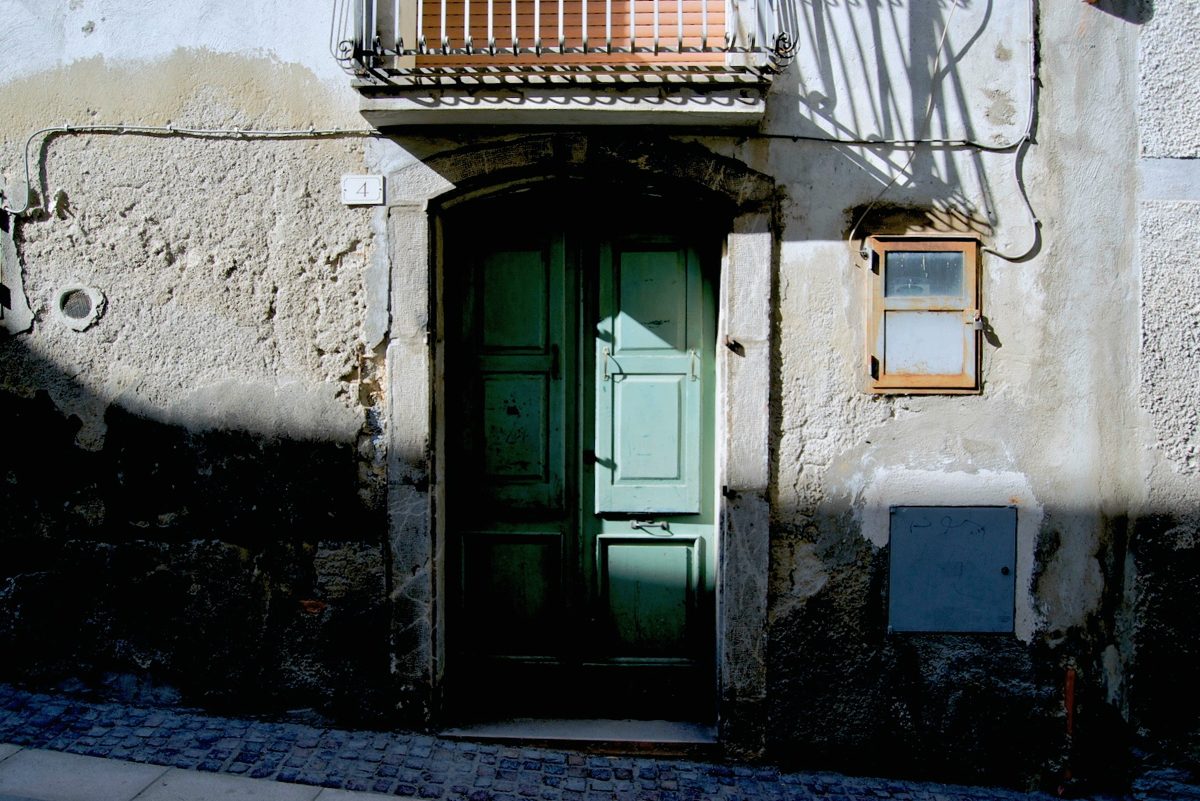
A door in Irsina ©Veronica Di Benedetto Montaccini 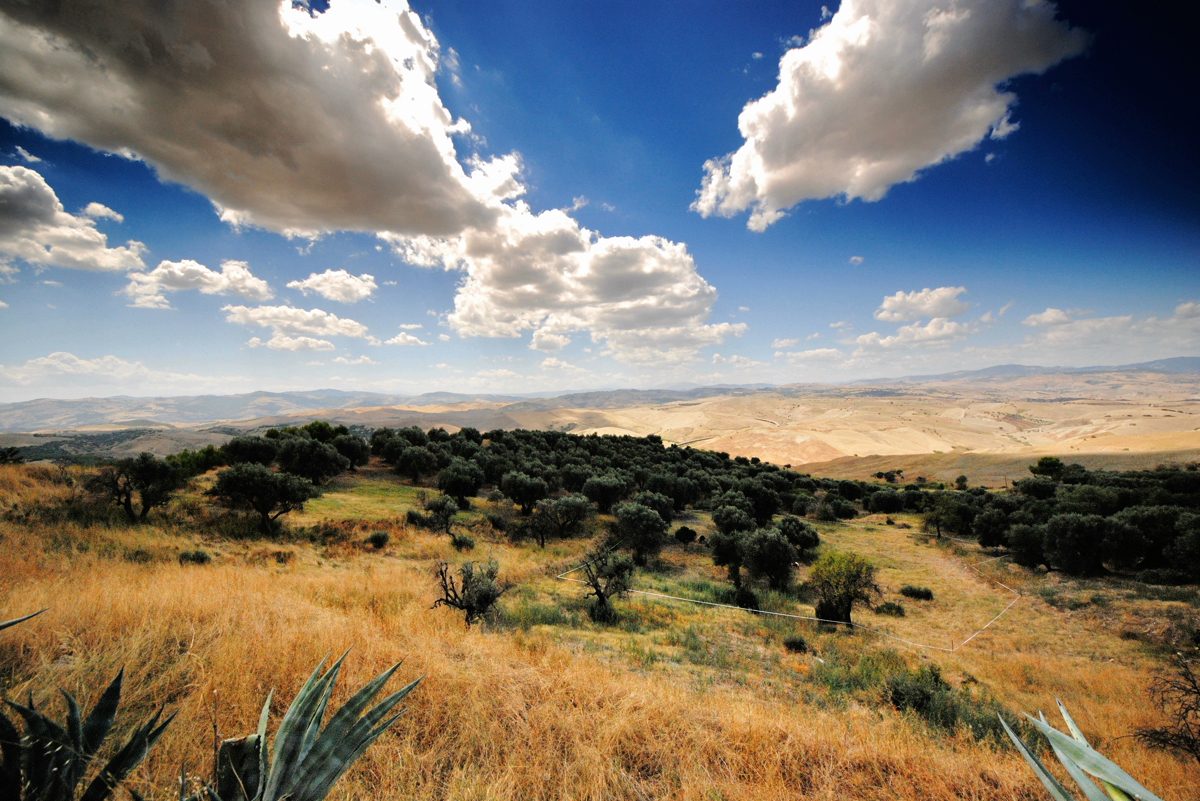
The land of cereals ©Veronica Di Benedetto Montaccini
For Nicola, being mayor is more than a job – more than city council meetings, decision making and signing papers. His phone rings constantly and he can barely take two steps before someone stops him on the street. Being mayor is a full-time passion. He smiles when showing us the beautiful details of his dear Irsina, all the while giving advice, stopping and talking to residents about their children’s schooling, even sometimes disappearing to help someone who needs him.
The city is perched on a hill roughly 550 metres above sea level; from Irsina one can gaze over the valleys of Bradano and Basentello. But the origins of the settlement date back to early man. Nestled in this ancient landscape, the historic city centre has seen a gradual decline in population due to high levels of economic emigration in the last 50 years. However, over the last decade the situation has started to reverse, thanks to the large number of foreign residents who have chosen to make their lives here.
“Sooner or later your origins call you back. You feel it”
Irsina fights back against depopulation by opening its doors. Many of the migrants are pensioners from all over the world who, thanks to affordable property prices and the close proximity of the Bari Airport (just over an hour away), decided to settle here and live a quiet and serene life in a small Italian village. “Thanks to them, our historic settlement has a new lease of life,” says Mayor Morea. “Infrastructure is being carefully restored and resources and investment are transforming Irsina into a little jewel of the south.”
Even if people aged between 19 and 40 have left the town, Irsina has gradually become more attractive to different demographics over the last 10 years. You only have to take a bike ride through the old town to notice that the names on the doors are not of Italian origin, but come from overseas. Sandy and Keith came to Irsina in 2006, the first foreign couple to buy a house here for their retirement. Swapping London for Basilicata, they came for peace and quiet – and above all the view. After them came Ann and Yann, she an ex-journalist and he a former programmer. The offer us wine and local delicacies while sat on their terrace in the heart of the town. You only have to see the look in their eyes as they gaze over the roofs of their new home to realize that, having traveled half the world, they have finally found their destination here. “Thanks to the internet and social networks you are so connected that you no longer need to live in London to work!” explains Ann.
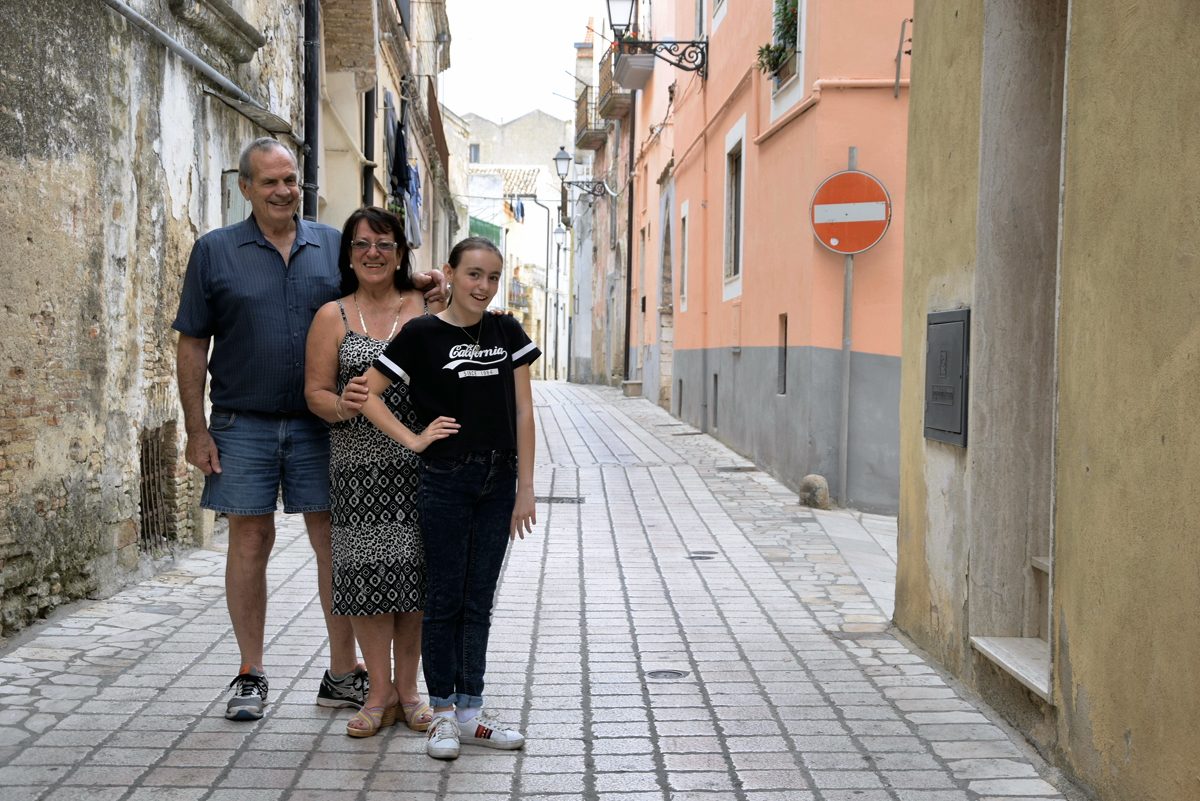
A family: from New Zeland to Irsina ©Veronica Di Benedetto Montaccini 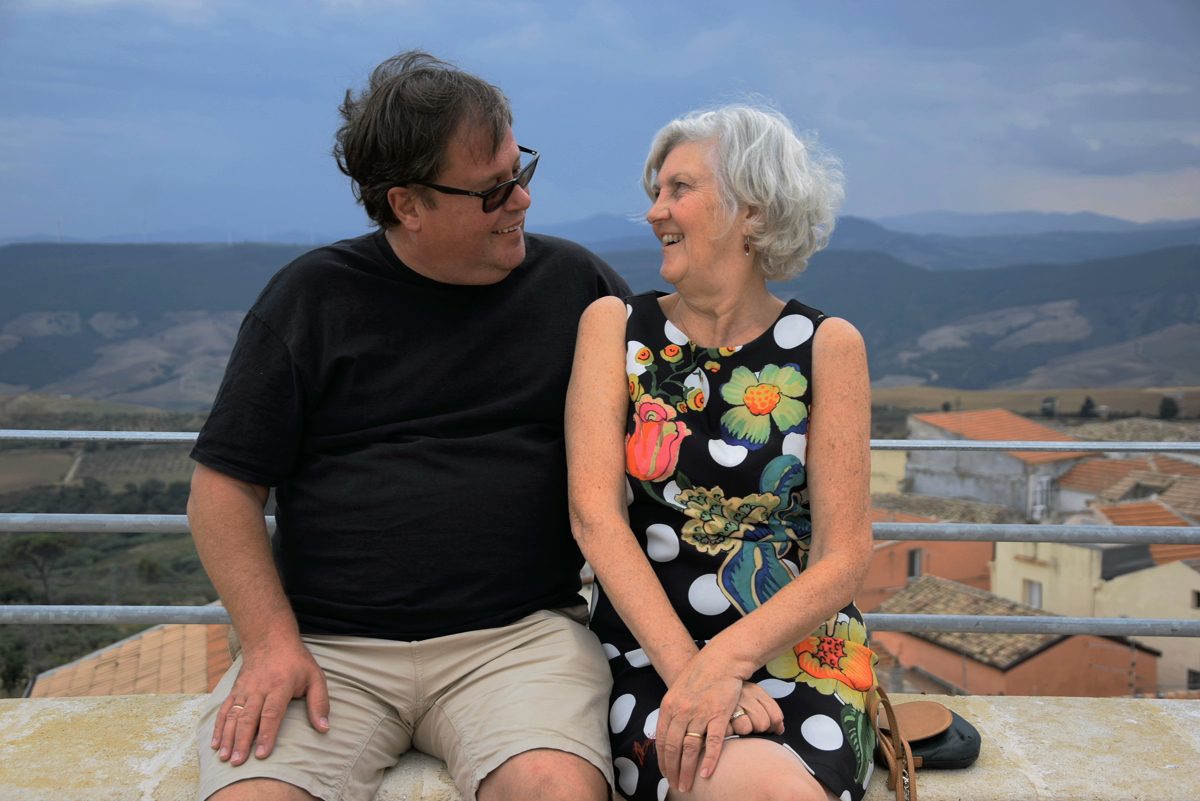
Yann and Ann ©Veronica Di Benedetto Montaccini 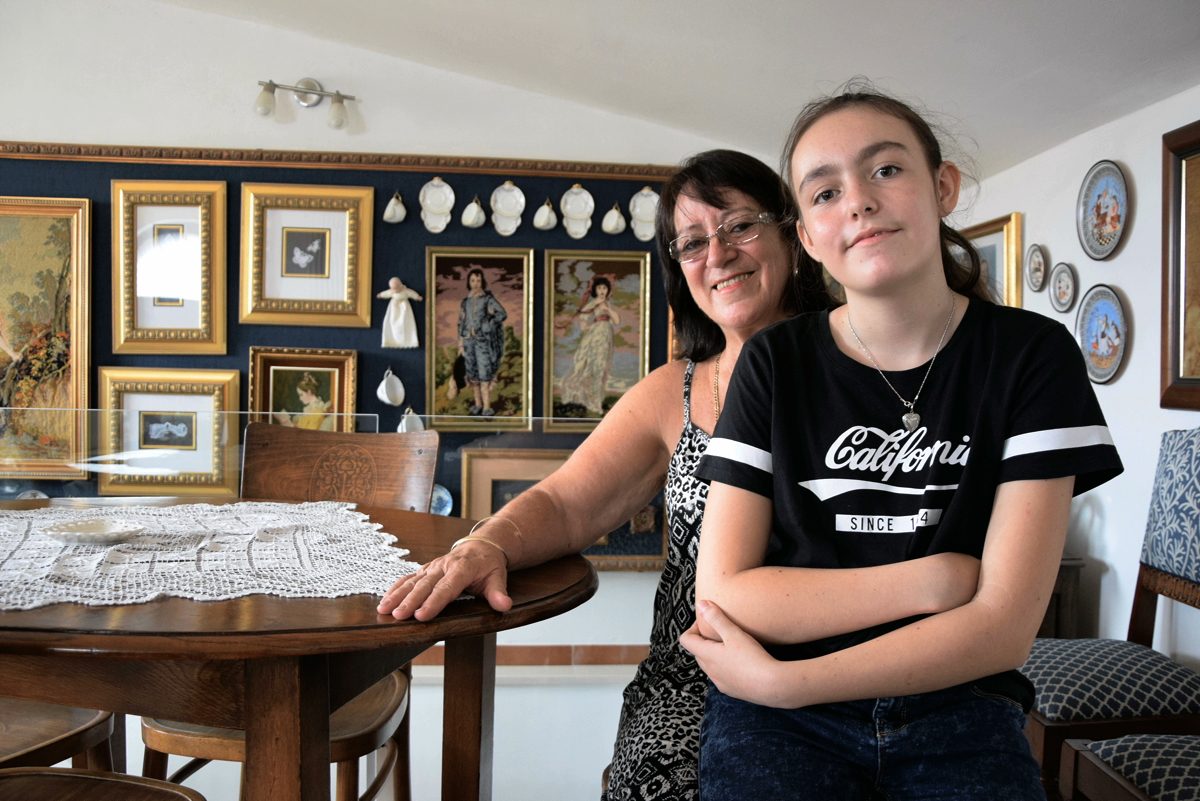
The youngest foreign citizen in the village ©Veronica Di Benedetto Montaccini
Rocchina Natale is Irsina’s much-loved architect, adored by these retired couples seeking to live in picturesque white stone houses. He builds and furnishes such dwellings, imbuing them with local flavour. “They leave everything with me – the keys, their credit cards. They trust me immensely and say that they have found peace here.” Until a decade ago it was difficult for Rocchina to find a steady job. Now there are people lining up for his advice. The new inhabitants have brought a fresh vitality to the town, and, most importantly, given hope to the younger generation, who have reinvented themselves in response to the new arrivals.
It’s early, and as the morning fog lifts away from the plateau, we notice strange pigs wandering the fields. At the sound of a whistle they run for their daily food ration. Calling them home is Giuseppe Signoriello, 33. He started his studies in animal husbandry and agriculture but Irsina’s siren song proved a stronger draw than the books. Choosing instead to remain in his hometown, he decided, together with two friends, to revive an almost extinct breed of pig – the Lucanian black pig. “We’re ambitious, we want to preserve the breed and control the entire supply chain: from breeding the animals, to the restaurant and people’s homes,” explains Giuseppe. His grill is called Fuoco Divino (Divine Fire) and serves dishes based around black pig. All the waiters and chefs are young men and women.
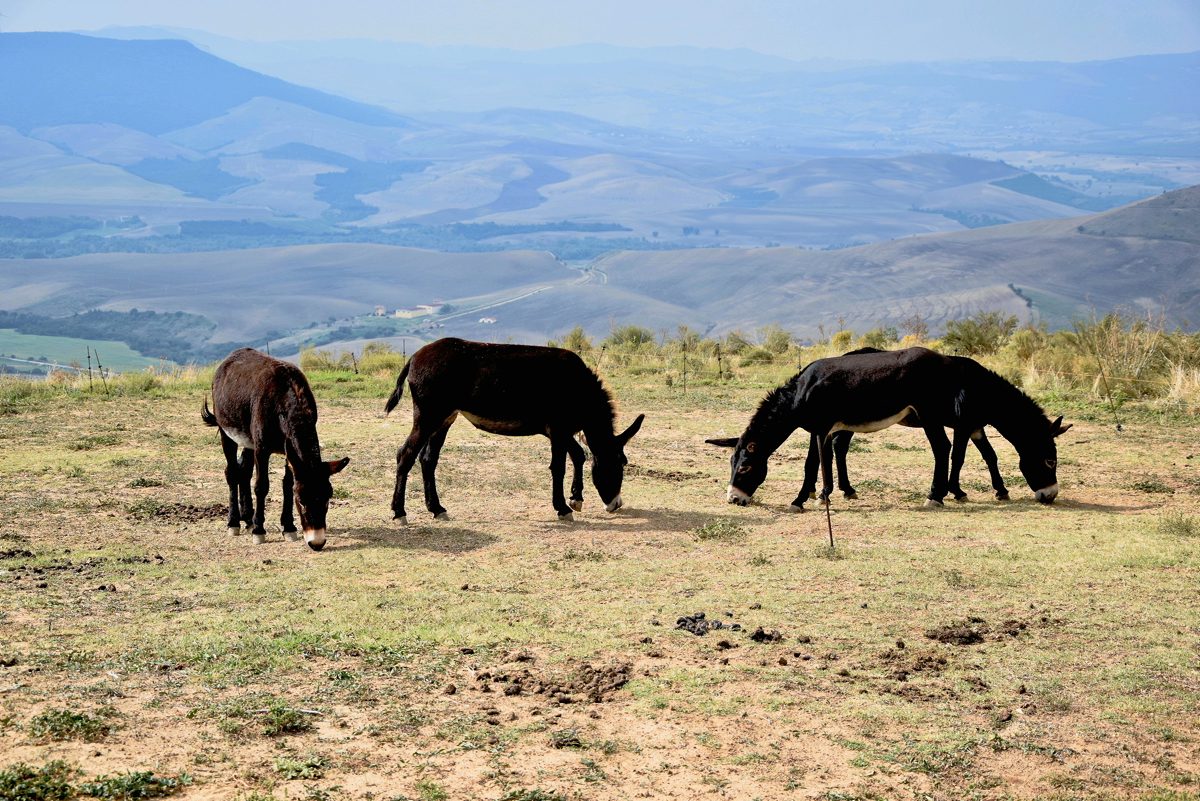
Not only black pigs ©Veronica Di Benedetto Montaccini 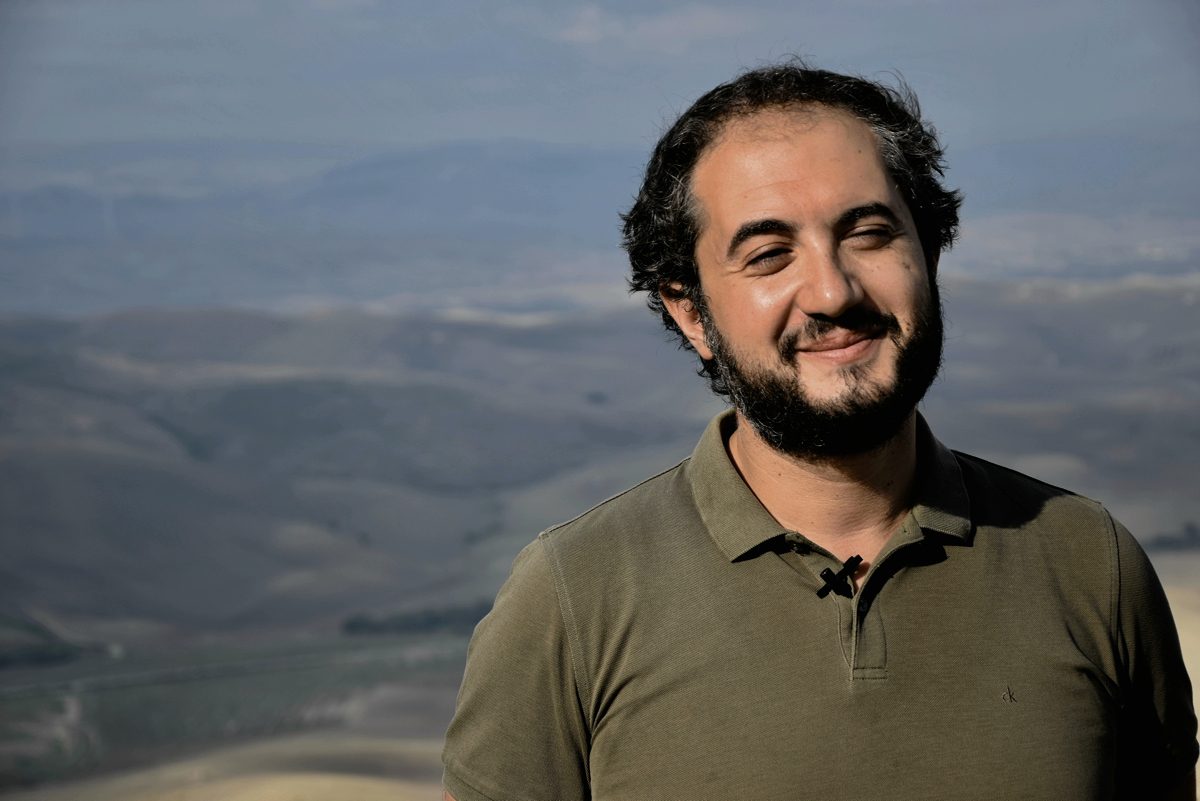
Giuseppe ©Veronica Di Benedetto Montaccini
Young people in Irsina don’t just work in agriculture. Angela, 36, is waiting for us in Irislab, her ceramics workshop. She opened the workshop one June morning 16 years ago. There wasn’t a tradition of the craft in Irsina. In many ways her work speaks for itself, but nevertheless she has a story to tell about each plate, coffee cup and sugar jar. As a child she was shy and introverted. She took to painting when she discovered that she could express herself with brushstrokes instead of words. “You can’t live on bread and art alone,” her grandparents would often tell her, but that didn’t matter to Angela. She attended art school, fell in love, became pregnant with her son at the age of 16 and, unlike her peers, chose to stay in Irsina. At the time the choice was a brave one, even more so because she was going against the trend.
“One day I bought my own ceramic oven,” says Angela as she arranges a tuft of blonde hair behind her ear and decorates a plate. She works in a small alley that overlooks a seemingly infinite horizon. “I wanted to feel what it was like to drink coffee from a cup I had made myself,” such a simple but fundamental ritual. It all started from there.
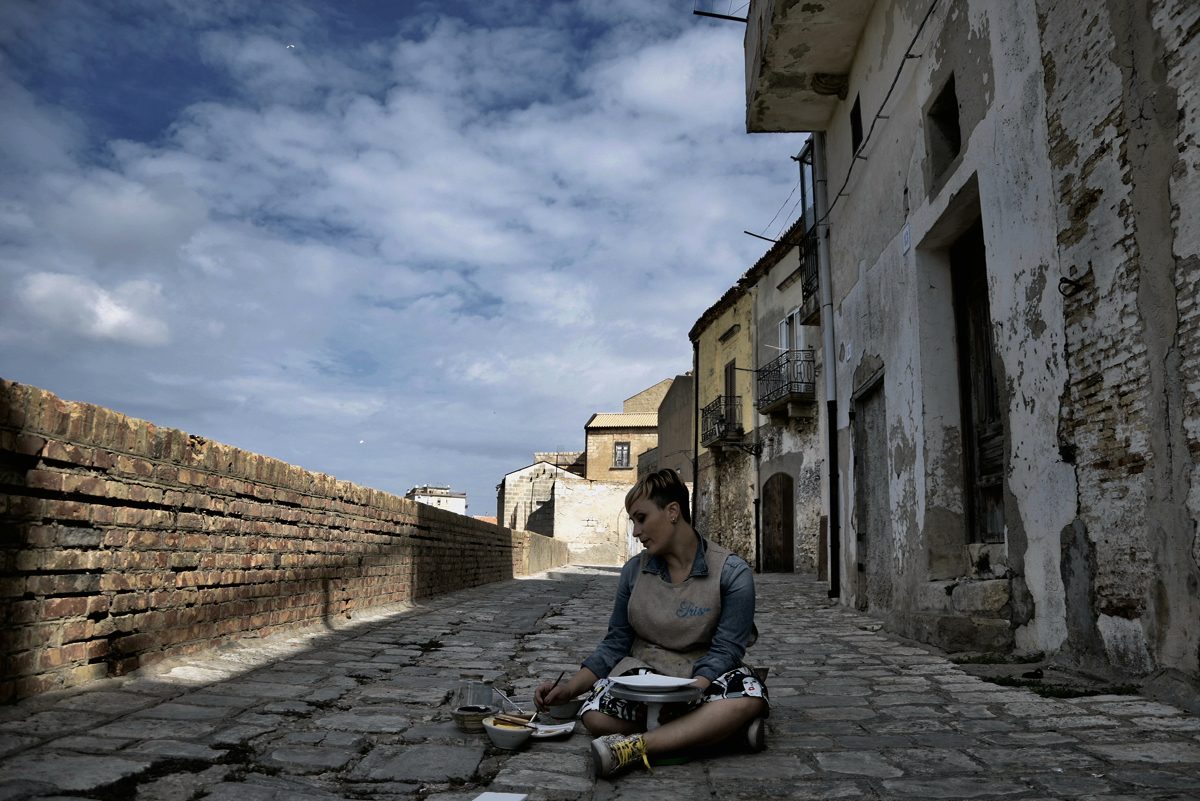
Angela Pisani ©Veronica Di Benedetto Montaccini 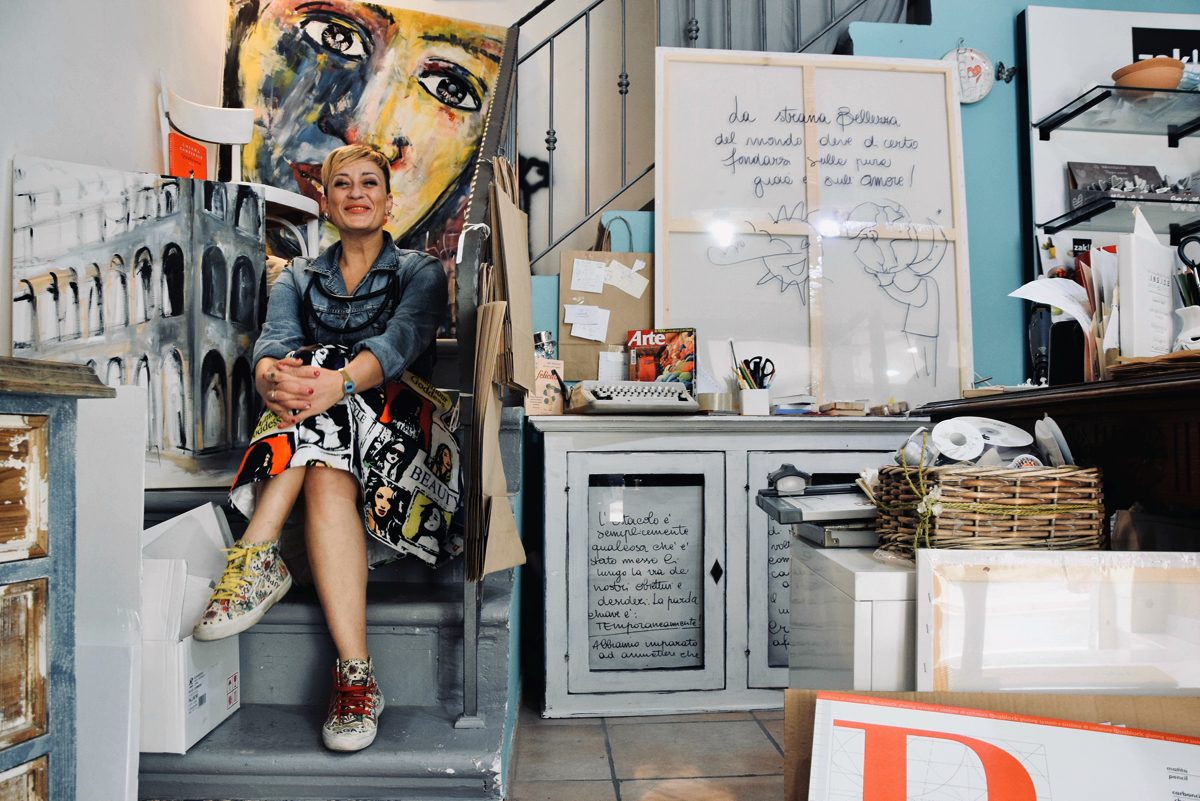
Angela and her atelier ©Veronica Di Benedetto Montaccini
“Whichever way you look out from Irsina you see an endless horizon,” she explains gazing off into the distance from one of Irsina’s beautiful vantage points. “I walk a lot, here. I collect the smells and stories of my homeland and try to translate them into art. This is a unique place where I can find the kind of silence that lets you be by yourself, just you and your thoughts. Sometimes it can be deafening. It’s true, you can sometimes feel alone. But all it takes is to open a map to realize that my husband, my two children and I, we are here, we are here.”
Angela manages to make a living from her work, even with all the difficulties involved in starting a business from scratch in a village. “You have to create something new every day. It requires a lot of passion. But you should never give up – as we have taught our children. You have to truly believe in what you do, otherwise you’ll end up depriving yourself of something. I feel free here. The city has never failed me. I organize and choose how I spend my own time. It takes courage, of course. But I want my peers to know that they don’t have to live in a big city, at a certain rhythm and a certain pace. You miss out on the little things. There are so many possibilities here, but perhaps people choose not to see them. They can’t look beyond the problems of living in the country.”
Borgo Taccone, the last ones left
There’s a surreal atmosphere when you first set foot in Borgo Taccone, only the barking of stray dogs breaks the silence and emptiness. There are abandoned haystacks and the word “unsafe” is scrawled on the wall of a nearby house. Worn-out asphalt streets have been eroded away to dust and mud.
Taccone is part of a cluster of villages built in the 50s designed to accommodate agrarian workers employed on the surrounding land. “A series of land reforms meant that there were incentives to move here in my grandparents’ time,” says Milena, an agronomist. She lives with her father and sister Maria. Together, they are the only family to stay in Borgo Taccone all year round. The other five or six families who still have a house here move away in certain seasons. “I sometimes get sad that I never leave my hometown. But then other times we are treated to absolute beauty.”
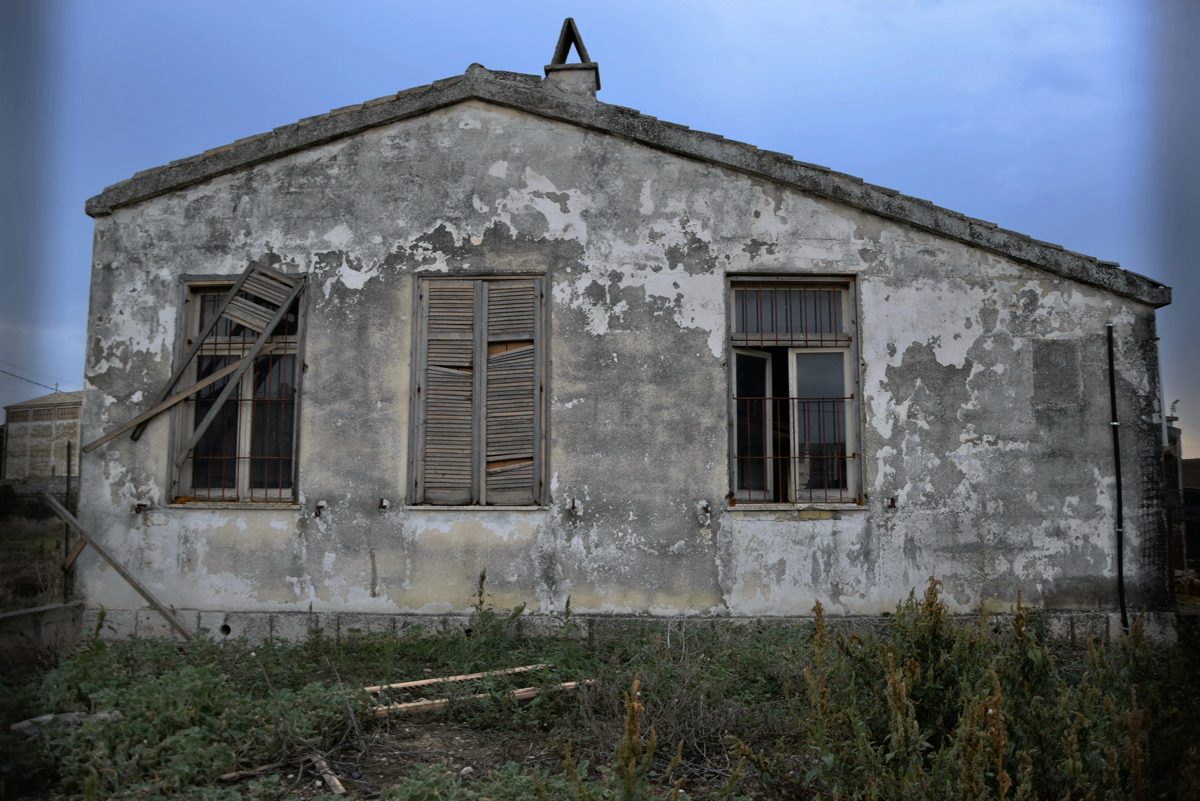
Crumbling house ©Veronica Di Benedetto Montaccini 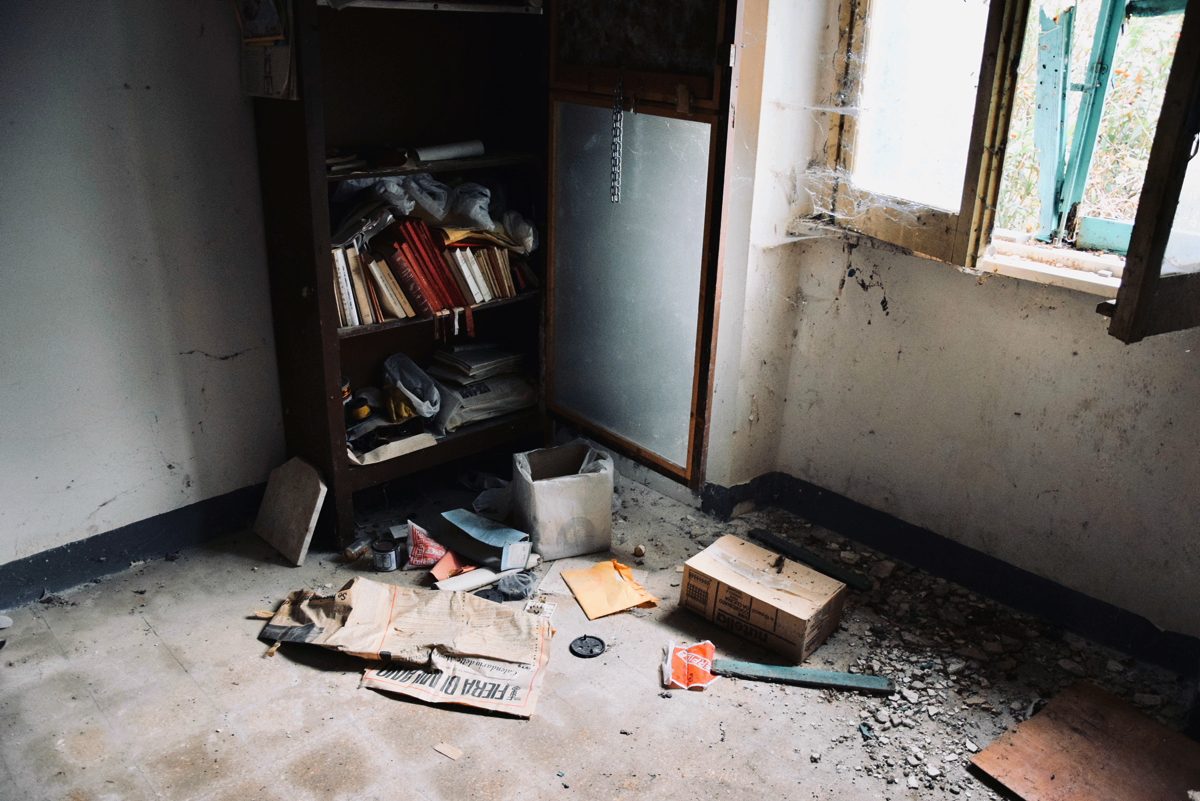
Memories ©Veronica Di Benedetto Montaccini 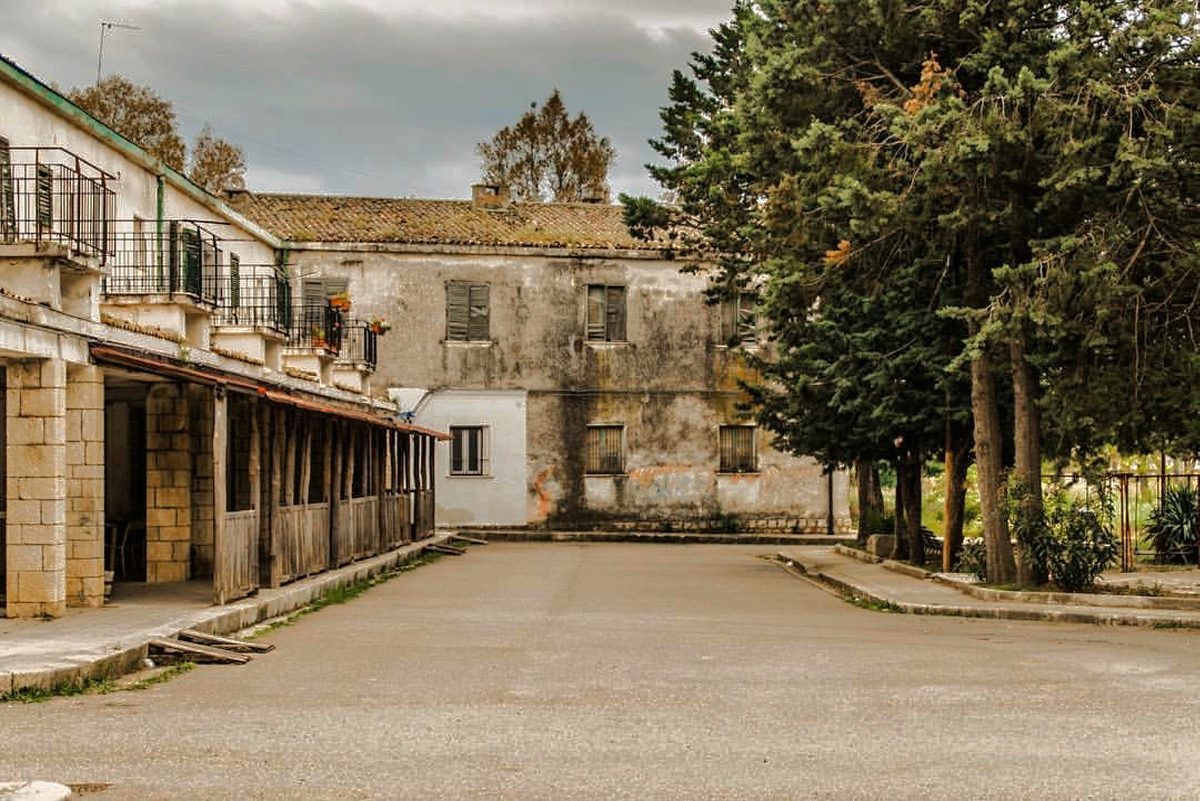
Borgo Taccone ©Veronica Di Benedetto Montaccini
“We had most things here until the 80s,” explains Milena. “The only thing missing was the school. But there were grocery stores, and the church. There are plans to renovate the town but nothing has come out of it yet. The hope is that the local authority will start investing, for example in our old cinema. Farmers used to go there to pass the time.” In order to find the front door of the movie theatre, you have to make your way through tall grass and thorns. The creaking red door opens into a bare room full of bird droppings. The films shown in this room are in one’s imagination, like in the film Cinema Paradiso.
“My father, Antonio, works in the fields. People who don’t live here don’t understand why we choose to stay. At the end of the day we have everything we need: water, electricity, clean streets… We are in close contact with nature. My father would die if he left his fields, and I travel across the province with my agronomy consulting business.” We walk as far as the old train track. In the distance we can see grain sprouting in the fields and hills of vivid green. Christ may have stopped at Eboli, but not even the train stops here now.
Giuseppe Las Casa, Professor of Technical and Urban Planning at the University of Basilicata, has dedicated much of his studies to cities with very few residents. He has some clear ideas. “If we include a social component in our definition of disasters, then we can say that these abandoned settlements constitute a disaster,” he explains. “The only way to stop population decline in Lucanian municipalities is to rethink the way in which services are provided. We need shared, centralised management of services. It’s an idea I often speak about but it’s difficult to put into practice. An important recurring theme is isolation. People think the solution is to build roads, but roads then have to be used. If I build roads between places where the average age of residents is very high, how will they be able to make use of those roads if I don’t guarantee public transport?”
Milena and her family do have a few complaints. “We pay taxes just like other Italian citizens but we don’t get the same benefits.” Transportation and infrastructure improvements don’t reach small towns in Basilicata. “But we’re not going to give up because of that. We want to use our expertise in agriculture and environmental techniques to make this area the reference for Lucan organic and permaculture traditions. For example, if we don’t preserve the Capello variety of grain, which is typical around these parts, it will be lost. We’ll see what happens.”
Milena doesn’t seem nostalgic for the past, despite the cracks in the derelict church walls, the holes in the street and the barred-off gates of houses once owned by farmers. She smiles with lips painted the colour of amaranth, and doesn’t let herself give in to the dreariness of her ghost town. On the contrary, she only has positive things to say about her roots. “What keeps me here? The beauty of the sky on a cloudless night, when you can admire this incredible cosmic panorama. When it’s completely dark, I look at the stars and ask myself, ‘Who else has a night’s sky like this?’”
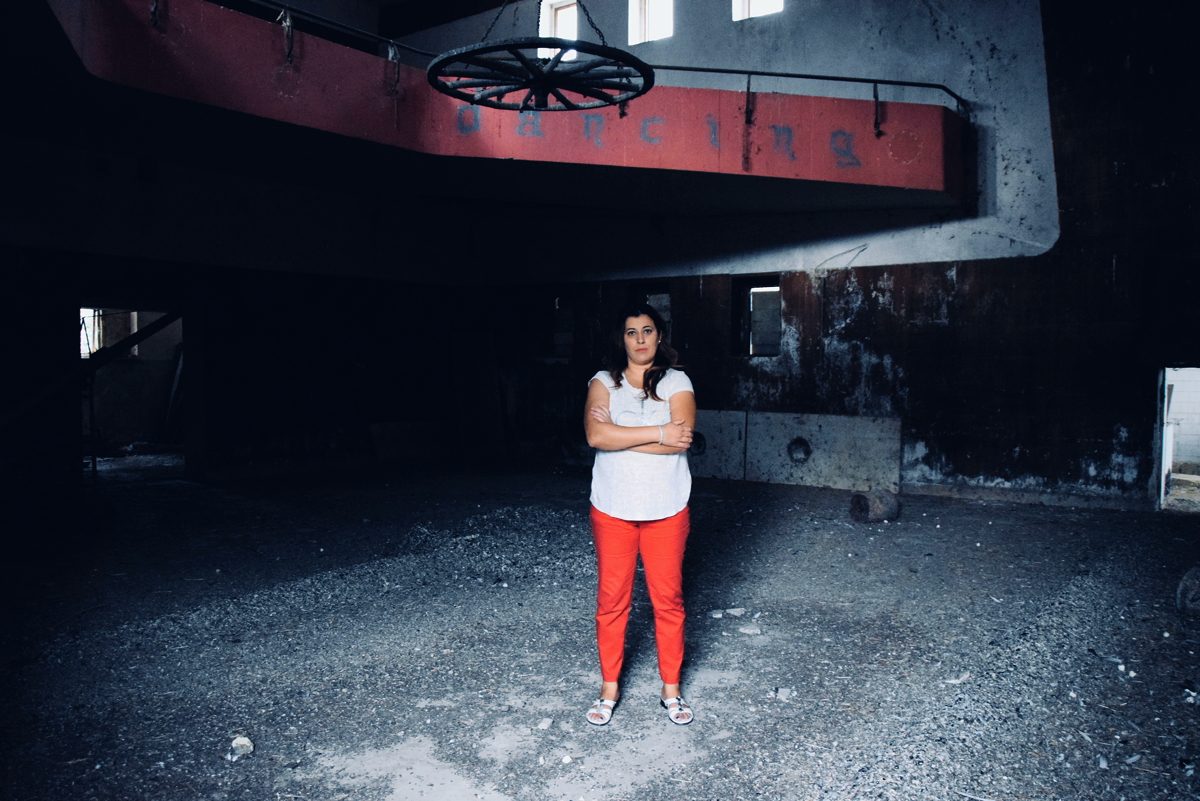
The old cinema ©Veronica Di Benedetto Montaccini 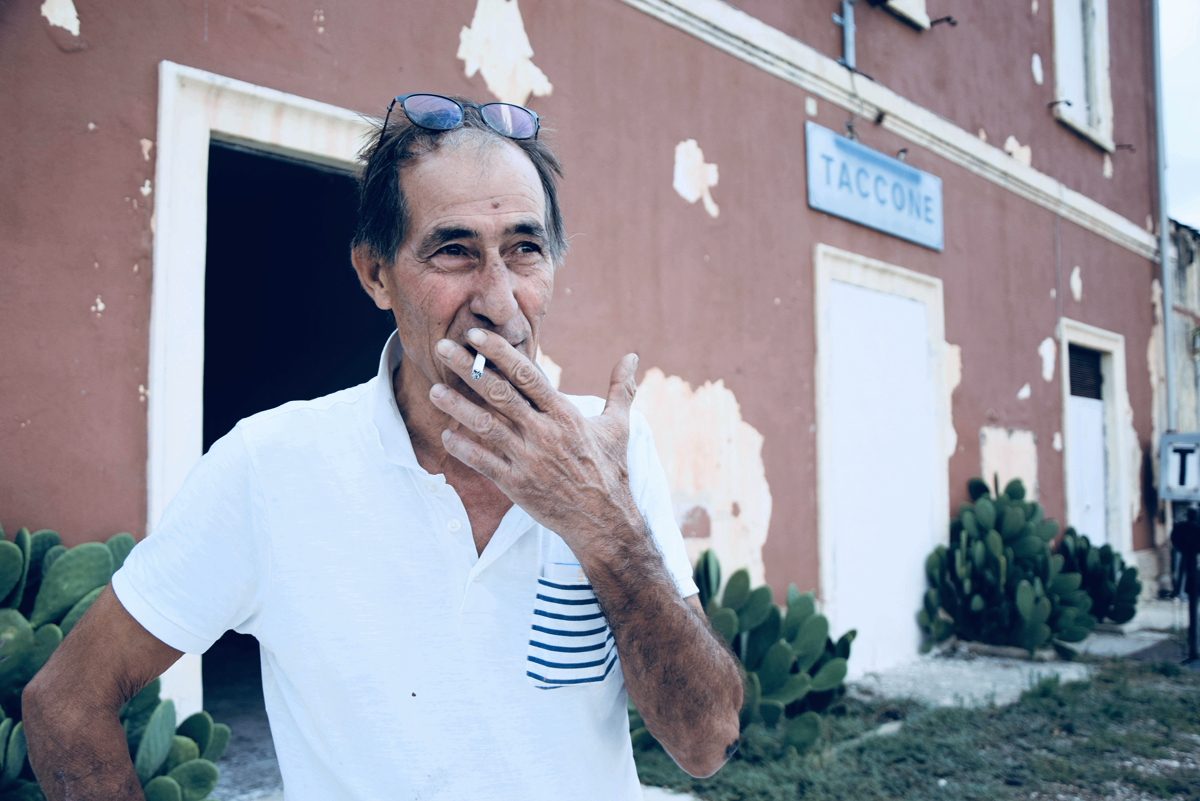
Tonino and the train station ©Veronica Di Benedetto Montaccini
Guardia Perticara, culture and oil
It’s the building material of the historic city centre that give this town the name “Stone House Country”. In recent years, many of the houses have sat empty in Guardia Perticara – a municipality of Val d’Agri, among the most beautiful stretches of countryside in Italy.
Until 31 August 2017, this town had only 542 residents. But the demographic fate of the municipality has been warded off by an unlikely new arrival: oil. The increase of mining in the area – with all the controversy and contradiction that came along with it – has proved a huge advantage for the residents of Guardia Perticara, at least in economic terms. The construction of the new Total Oil Centre brought hundreds of workers to the area.
“For several years now, more people have gravitated to our town,” says the mayor, Angelo Mastronardi. “The population has almost doubled and most of the previously uninhabited houses are now rented.” He argues this is a positive development when it comes to employment in the region.
We meet Giacomo, Enzo and Luigi – three oil workers in their 40s – in the main square of the village. It’s 6pm and, at this time, an army of orange suits heads back to the city from the Total factory, hands dirty with oil grease, faces tanned. “I come from Calabria,” Giacomo explains, his blue eyes are very intense. “I feel good here. They gave us a discounted price on the houses and in the evening we meet up with other workers. A community has been created.”
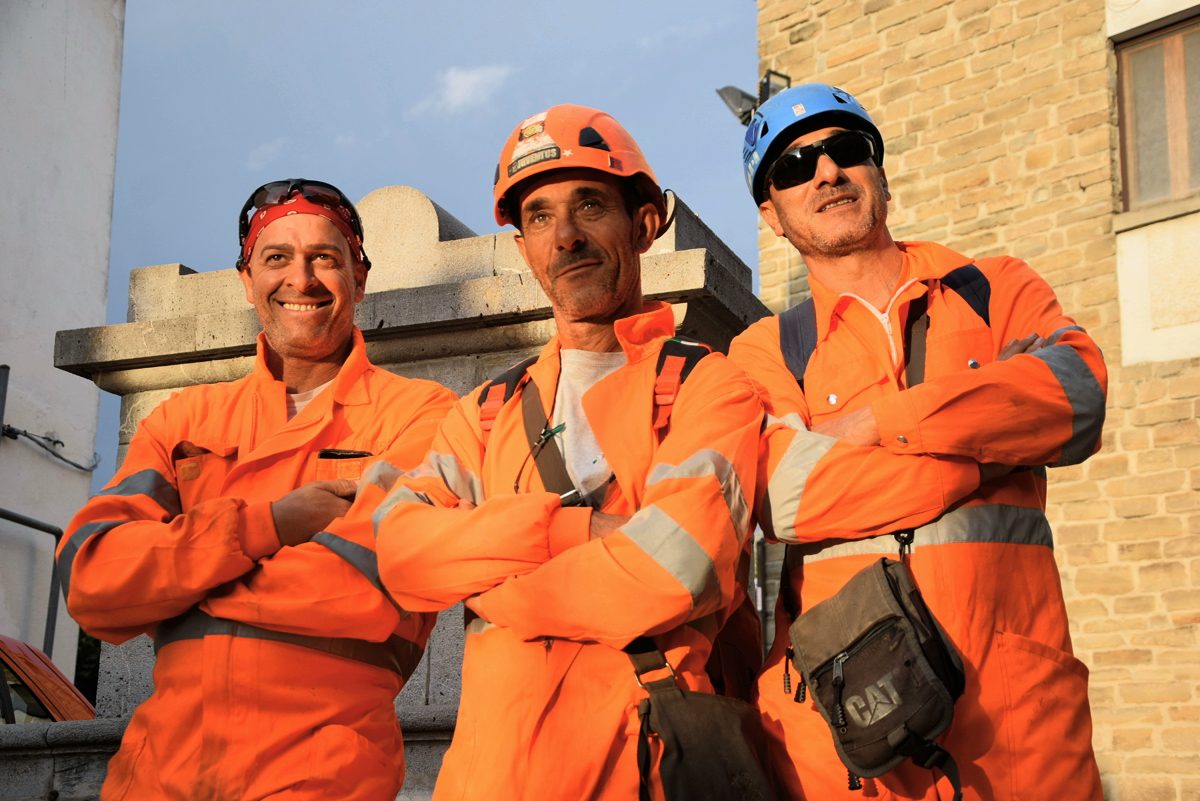
Working class hero ©Veronica Di Benedetto Montaccini 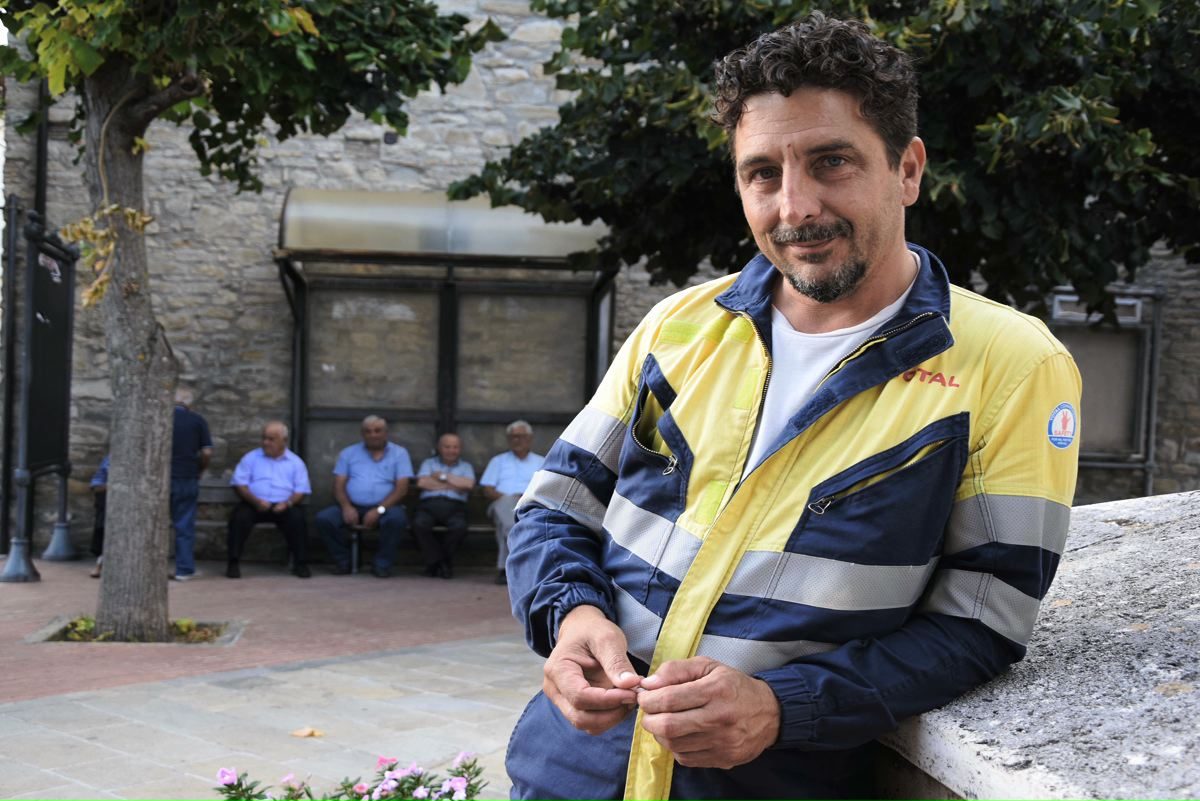
The young and the old generation ©Veronica Di Benedetto Montaccini
Val d’Agri’s economic boom is not, however, expected to last forever. “It can’t be denied that at this point in time the oil supply chain brings a consistent source of income to the village. But I can’t say that it will be true forever. This occupation is linked to the present. When the construction of the Total centre is finished and the plant starts working, we won’t need as many workers,” says the mayor. At that point, unemployment could become a problem again.
“For those interested in working in oil right now, there are many possibilities,” says Lucia, a girl from Guardia Perticara who attends the Hotel Institute in Potenza and, in the summer, works in the only bar in the village square. “But people who want to do other things don’t have much choice. People who come from elsewhere appreciate Guardia Perticara for its tranquillity. But for people who live here, things are different. There is only one grocery store and no way to buy clothes.” Does she think she’ll stay here? “I still haven’t decided what to do in life, but I haven’t ruled out the possibility of leaving.”
It’s true that many people have left over time, to the point that the secondary school was closed for two years because not enough students were enrolled to keep it in the black. “The kids attend middle schools in Armento or Corleto Perticara, nearby villages,” explains Mayor Mastronardi.
“For those interested in working in oil right now, there are many possibilities. But people who want to do other things don’t have much choice”
It’s not only to get an education that people leave Guardia, it’s for entertainment too. The nearest cinema, for example, is in Potenza. In order to see a film on the big screen you have to travel 60 kilometres of winding roads, which are particularly unforgiving in winter. To make up for this lack of leisure amenities, the mayor put in place a bus that takes inhabitants to the Potentino cinema. The idea didn’t go down so well with citizens in the end. “We only managed to get it together to see one Christmas movie,” Mastronardi says with regret.
Despite a scarcity of infrastructure, the town has for years been committed to providing cultural offerings both for the inhabitants and the tourists who come to Guardia. There are four permanent museum exhibitions on-site, showcased in a historic building in the countryside. In the past, there was also a municipal library. “Since newspapers weren’t getting delivered to the village, the previous administration decided to keep the city library open so they could get newspapers and magazines delivered there,” explains the mayor. “It was run by young people in the village, who alternated in the role every couple of months.”
The library has not lost its importance; it recently received an important donation from someone very close to the city. “My father was a very cultured man,” explains Rosi Massari, a Milanese lawyer and the daughter of Franco, a university professor originally from the village. “He had a library of about 2,000 books that, after his death, I could not keep at home. So I gave it to Guardia – to the village where he was born and to which he was very attached – as an invitation to read and rediscover culture. My father had a great love for his hometown and he passed that on to me. Despite being born and raised in Milan, I think of Guardia as an oasis of authentic values, a happy island. I wouldn’t like to see it disappear.”
Rosi returns to the village every summer to organise cultural events. The last one – “AvanGuardia” – is a festival dedicated to art in all its forms. “Because culture,” he continues, “raises awareness of the beauty of my homeland and even enhances it. This is what I would like to see happening in Guardia too.”
Craco: an open-air film set
This ancient Italian village is a curious contradiction. How could somewhere left uninhabited for decades after a landslide become such a destination for curious tourists? The new part of town, is an anonymous place, sad, populated by just a few hundred people who have to travel to neighbouring settlements to take advantage of public services that are not available in the village where they live.
The words “bread and work” can be glimpsed in faded red letters on the facade of Palazzo Grossi, the former home of local landowners. These two demands were written by rural workers before the agrarian reforms. Craco, a small town in the Matera province, mostly cultivated wheat until the 1960s. It produced so much that 2,000 local residents were not enough to work the lands owned by these wealthy families – labourers also came in from Salento.
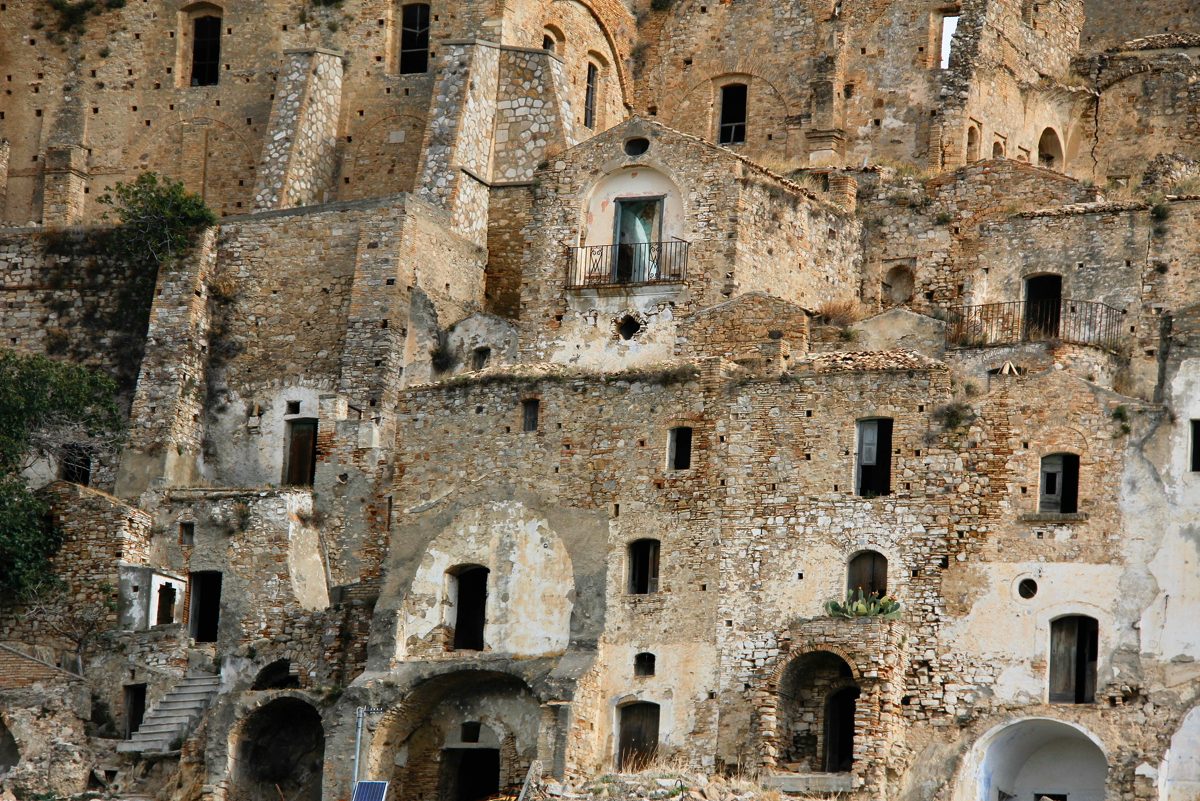
The rocks ©Veronica Di Benedetto Montaccini 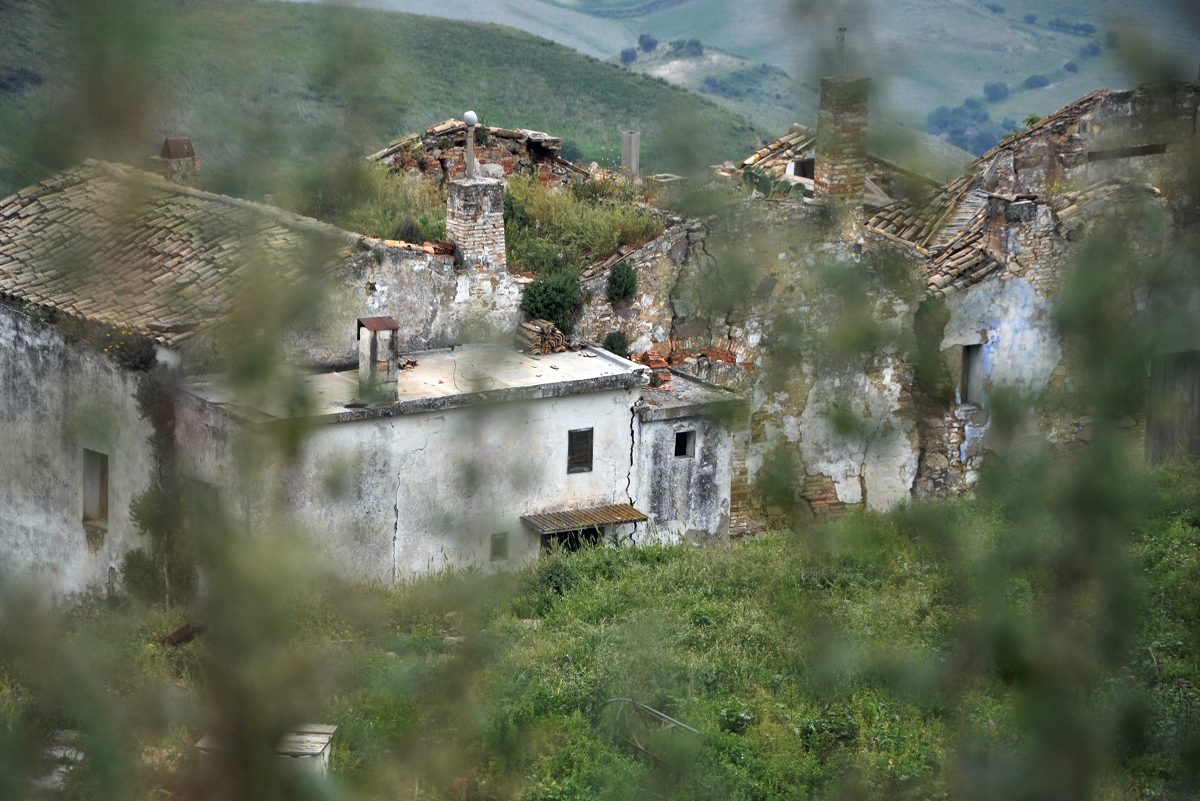
Old houses ©Veronica Di Benedetto Montaccini 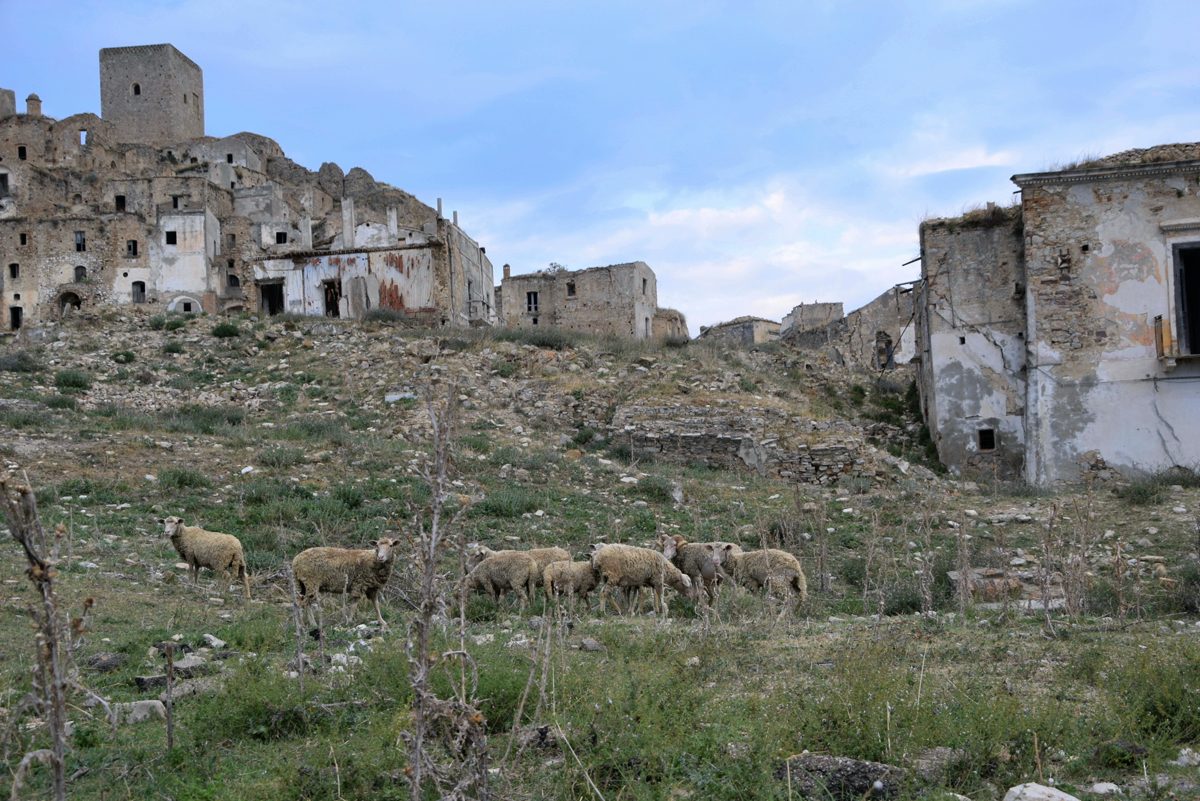
Craco and the sheeps ©Veronica Di Benedetto Montaccini
The land was redistributed after the reforms, but they are no longer cultivated today. The European Union pays landowners to keep them unfarmed. That former farmland, perched on a hillside surrounded by ravines – already a settlement during the Norman and Byzantine conquests – no longer exists. It started disappearing in 1963 when landslides threatened the homes of the people who lived there. It was a slow-acting failure that could have been stopped. Mankind’s blindness worsened its destructive power.
“One American engineer – in 1967, when the landslide was 20 meters deep – suggested creating tree-shaded terraces,” explain Antonio and Mafalda, a resilient couple who lives in one of the popular houses on the slopes of Old Craco with their wild-looking great Maremma sheepdog. “The local technicians, however, preferred to build two large retaining walls that started showing signs of giving way less than five days after construction. By 1974, people were leaving the area. You should have seen Craco when it was full of life, not now that it’s died.”

Antonio and Mafalda ©Veronica Di Benedetto Montaccini 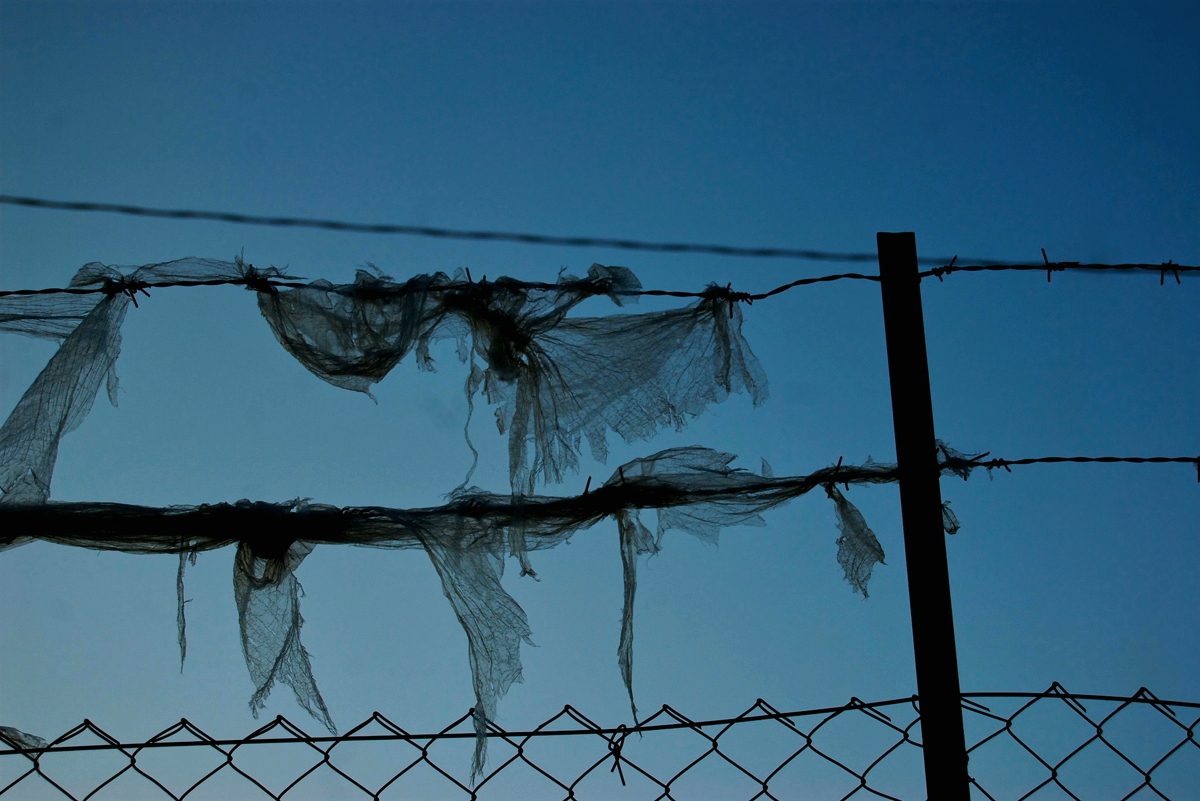
The sky in Craco ©Veronica Di Benedetto Montaccini
What remains today is a backdrop of ancient beauty, that has for decades been scouted as the location for movies and short films. Known directors, from Francesco Rosi to Mel Gibson, have selected the town as a filming location. Filming is a huge source of income for the town, which since 2009 has started work on renovating its historic centre. In order to enter the town you have to pay 15 euros – going up to 40 if you want to take pictures.
Despite the ticket price, more and more tourists are struck by the fascinating desolation of Craco’s winding alleys. “In 2010, 1,500 people visited the site. In 2016 there were 15,000,” says Antonio, offering us Crodino in a limescale-encrusted glass. “By putting this operation in place, the village has been saved from vandals, as well as the weather and the goats that wander undisturbed through the streets.” In short, after years of neglect, the local administration, together with a cooperative of about 15 people, is helping this place to flourish. It’s a village that – contrary to what Rocco Papaleo said in his film Basilicata Coast to Coast – did not “reject modernity” but was worn down partly by nature, partly by neglect.
The alleys of Craco cannot be repopulated by those who were born and raised among these stones, nor by their children. But those houses are still there, waiting, and, despite the cracks, they resist time, remembering how much damage human superficiality can do.
San Paolo Albanese, endangered traditions
San Paolo Albanese is the smallest town in Basilicata. Over the last 10 years it has experienced the region’s biggest rate of population decline. The village – founded by Albanians fleeing persecution by Ottoman Turks – risks disappearing in a few years. Sitting in front of her bar, Paola dries her glasses with calm and dedication. When asked how long it will be before she finishes work, she answers that it takes time and patience.
We struggle through our conversation in Italian, because it is not her native language. Paola, 26, is one of the few young people left in San Paolo Albanese (population 253), one of five Lucanian towns of Arbëreshë origins. It was founded in the 16th century by a community of Albanian refugees who escaped from invading Ottoman Turks.
“We lost 100 residents in the last decade. An average of 10 people per year. And we are losing the “alberesh” language as well”
The inhabitants of San Paolo are mostly Albanian in origin. Many are senior citizens, the average age in the village is 54.2, compared with 45.7 across the Basilicata region. They preserve their Albanian language and religious traditions, even as less and less people know about them. Walking through the semi-deserted streets of the village, it’s easy to hear people conversing in ancient Albanian, a language that they hold on to closely, “Our area has suffered from severe depopulation. We lost 100 residents in the last decade. An average of 10 people per year,” explains Maria, a tour guide in the town. “Sao Paolo is a very beautiful place, but everyday life here is difficult.” Maria is also responsible for preserving the activities and customs of São Paulo via a cultural gem: the Arbëreshë Museum of Culture. In these rooms you can follow the steps of broom processing – from which fabric thread was made – and take a look at the traditional clothes of the village.
When you live in such a small place you need to travel for almost everything you need. Sometimes, even just to buy bread. With the exception of a local store that sells a bit of everything there is nothing else in the village. Not a butcher, not a clothes store, not a post office. The on-call doctor doesn’t work nights and, since 2011, the primary school has also been closed. The lack of schools in the village increases the risk that children who do not speak Arbëreshë in their families will have no way of learning the language of their community.
There is a way, however, to be immersed in the tradition. Just a short walk from the museum is the village church. There Mass is celebrated with Byzantine Greek rites, the religion of the Arbëreshë populations. Every Sunday the bells ring and one after the other – without holding too closely to the allotted time schedule – the faithful arrive. When the church is full, the parish priest begins the celebration.
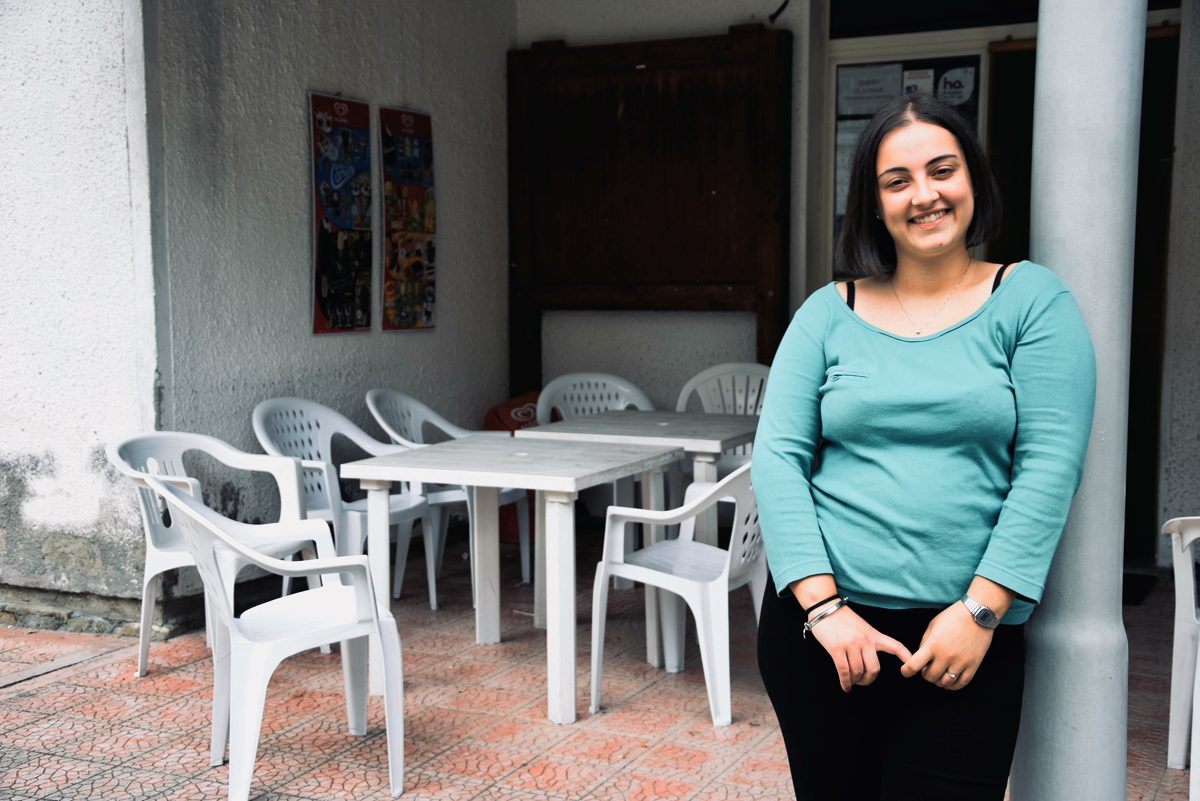
Paola ©Veronica Di Benedetto Montaccini 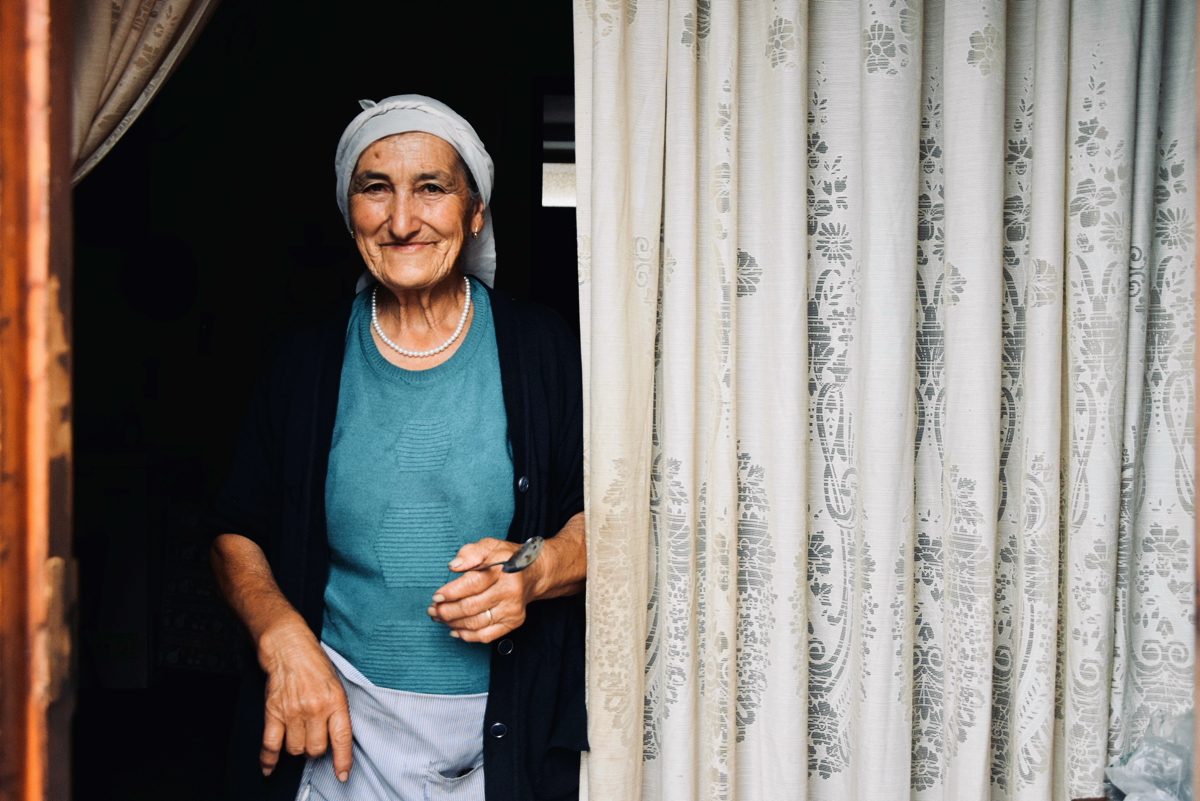
An old arbëreshë grandma ©Veronica Di Benedetto Montaccini 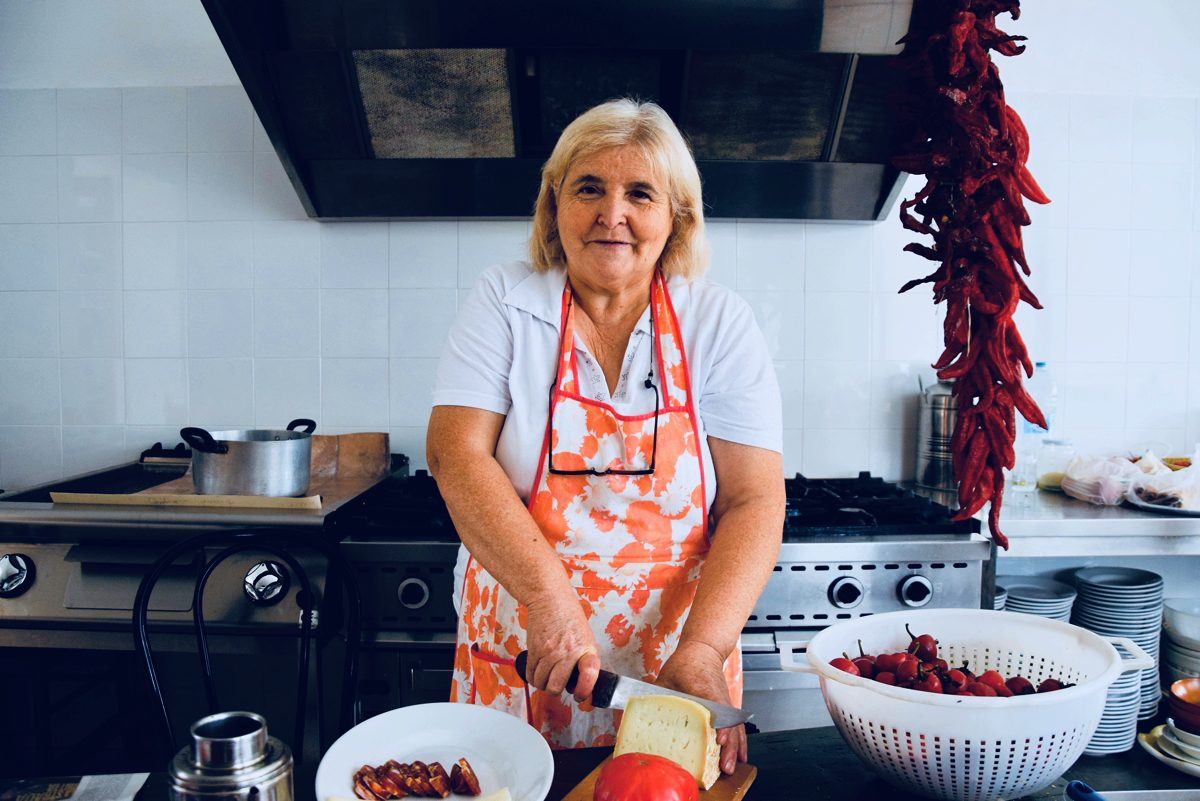
Luigina, the official cooker in San Paolo Albanese ©Veronica Di Benedetto Montaccini
Among the pews, full of silver-haired people singing hymns in Arbëreshë, this dying village seems very much alive. Depopulation seems just a mirage, an invention of far away sociologists.
“And then run, run! Run to your land that waits for you. This wheat-and-sun land. This land that is only joy.” Song lyrics in the dialect of singer-songwriter Pietro Cirillo, describing the many ways that villages resist depopulation. Looking at the data, Basilicata may seem at death’s door. But maybe, carried by the wind that caresses the tomatoes left to dry on balconies in the sun, there is an unshakable will to live.
*Thanks to Tommaso Gasperotti and Davide Lanzilao because, each in his own way, they helped us in this amazing journey.



